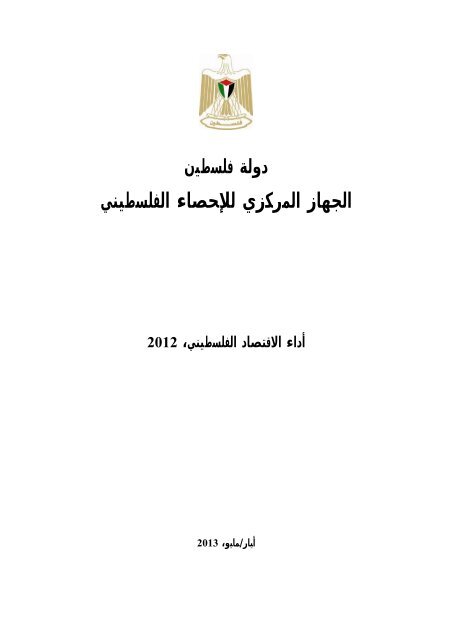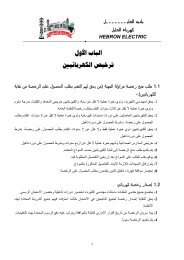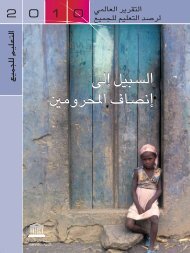أداء اÙاÙتصاد اÙÙÙسطÙÙÙØ 2012 - Palestinian Central Bureau of ...
أداء اÙاÙتصاد اÙÙÙسطÙÙÙØ 2012 - Palestinian Central Bureau of ...
أداء اÙاÙتصاد اÙÙÙسطÙÙÙØ 2012 - Palestinian Central Bureau of ...
Create successful ePaper yourself
Turn your PDF publications into a flip-book with our unique Google optimized e-Paper software.
دولة فلسطينالجهاز المركزي للإحصاء الفلسطينيأداء الاقتصاد الفلسطيني، <strong>2012</strong>أيار/مايو،2013
PCBS:اداء الاقتصاد الفلسطيني، <strong>2012</strong>تم إعداد هذا التقرير حسب الإجراءات المعيارية المحددة فيالممارسات للإحصاءات الرسمية الفلسطينيةميثاق2006©رجب، 1434ه–جميع الحقوق محفوظة.2013. أيار،في حالة الاقتباس، يرجى الإشارة إلى هذه المطبوعة كالتالي:الجهاز المركزي للإحصاء الفلسطيني،2013. أداء الاقتصاد الفلسطيني، <strong>2012</strong>. رامفلسطين. - االلهجميع المراسلات توجه إلى:الجهاز المركزي للإحصاء الفلسطينيفلسطين. االله - رام 1647، ص.ب:هاتف:فاكس:الرقم المجاني:(970/972) 2 298 2700(970/972) 2 298 2710بريد إلكتروني:صفحة إلكترونية:1800300300diwan@pcbs.gov.pshttp://www.pcbs.gov.ps
PCBS:اداء الاقتصاد الفلسطيني، <strong>2012</strong>فريق العملإعداد التقريرمهند حمايلمحمد قلالوة•تدقيق معايير النشرحنان جناجرة•المراجعة الأوليةد. محمد نصرد. صالح الكفريإبراهيم الطرشةعميد كلية الأعمال والاقتصاد- جامعة بيرزيت•المراجعة النهائيةمحمود جرادات•الإشراف العامعلا عوضرئيس الجهاز•
PCBS:اداء الاقتصاد الفلسطيني، <strong>2012</strong>
PCBS:اداء الاقتصاد الفلسطيني، <strong>2012</strong>تقديماستمرارا ً لسياسة الجهاز المركزي للإحصاء الفلسطيني في تطوير وتحديث تقاريره الإحصائية، تم إعداد تقرير الأداءالاقتصادي في فلسطين للعام،<strong>2012</strong>ليوفر أداة للباحثين وصانعي السياسات الاقتصادية لرسم صورة للواقع الاقتصاديمن خلال دراسة المؤشرات الاقتصادية المختلفة، مثل مؤشرات الناتج المحلي الإجمالي، وسوق العمل، والأسعار،والفقر، وميزان المدفوعات، والتجارة الخارجية، والقطاع الحكومي، ورخص الأبنية، حيث يوفر هذا التقرير وصفا ًإحصائي ًا لطبيعة وكيفية الأداء الاقتصادي، مما يتيح المجال للمقارنة والقياس والتحليل الاقتصادي.يسرنا تقديم هذا التقرير حول الأداء الاقتصادي فيفلسطين للعام،<strong>2012</strong>ومقارنتها مع الفترة المناظرة لها من العامفلسطين.متضمنا ً أبرز مؤشرات الاقتصاد الكلي2011، بحيث تعكس التغيرات على الأوضاع الاقتصادية وتباينها فينأمل أن يسهم هذا التقرير بإعطاء صورة عن طبيعة وكيفية أداء الاقتصاد الفلسطيني خلال العام <strong>2012</strong>، وأن يوفرالأداة التحليلية لهذا الأداء، ما يساعد المهتمين والباحثين في دراسة التغيرات الاقتصادية على الساحة الفلسطينية.واالله ولي التوفيق،،،أيار،علا عوضرئيس الجهاز2013
PCBS:اداء الاقتصاد الفلسطيني، <strong>2012</strong>قائمة المحتوياتالموضوعالصفحةقائمة الجداولقائمة الأشكال البيانيةملخص أداء الاقتصاد الفلسطينيالأداء الاقتصادي للعام<strong>2012</strong>152024262729313334-1-2-3-4-5-6-7-8-9الناتج المحلي الإجماليسوق العملالأسعار والقوة الشرائيةالفقرميزان المدفوعاتالتجارة الخارجيةالمالية العامةالقطاع المصرفيالأنشطة الاقتصادية
PCBS:اداء الاقتصاد الفلسطيني، <strong>2012</strong>
PCBS:اداء الاقتصاد الفلسطيني، <strong>2012</strong>قائمة الجداولالجدولجدولجدولجدولجدولجدولالناتج المحلي الاجمالي في فلسطين بالأسعار الثابتة،الصفحة1718202225(<strong>2012</strong>-2004)نسبة التغير في القيمة المضافة للأنشطة الاقتصادية حسب المنطقة،بعض مؤشرات سوق العمل للأفراد(<strong>2012</strong> ،2011)15سنة فأكثر في فلسطين،نسبة التغير في أعداد العاملين حسب النشاط الاقتصادي في فلسطين،(<strong>2012</strong>-2004)(<strong>2012</strong> ،2011)الرقم القياسي لأسعار المستهلك والوزن النسبي حسب المجموعات الرئيسية لأسعار:1:2:3:4:5المستهلك، في فلسطين،(2011،(<strong>2012</strong>26جدولفجوة وشدة الفقر حسب المنطقة،(2011 ،2010):627-2004)جدولأبرز المؤشرات التي تدخل ضمن تركيب الحساب الجاريفلسطين، في:7(<strong>2012</strong>30جدولأبرز عشر سلع تم استيرادها إلى فلسطين،2011:830جدولأبرز عشر سلع تم تصديرها من فلسطين،2011:934جدولأبرز الأنشطة الاقتصادية وأهم خصائصها في فلسطين،<strong>2012</strong>:10
PCBS:اداء الاقتصاد الفلسطيني، <strong>2012</strong>
PCBS:اداء الاقتصاد الفلسطيني، <strong>2012</strong>قائمة الأشكال البيانيةالشكلشكلشكلشكلشكلشكلشكلشكلشكلشكلشكلشكلشكلشكلشكلشكلشكلشكلشكلشكلشكلالناتج المحلي الإجمالي بالأسعار الثابتة في فلسطين،الصفحة1617192121222324262628282931323232333536(<strong>2012</strong>-2004)نصيب الفرد من الناتج المحلي الإجمالي بالدولار الامريكي حسب المنطقة،مساهمة الأنشطة الاقتصادية في الناتج المحلي الإجمالي في فلسطين،معدل البطالة في فلسطين،(<strong>2012</strong>-2004)<strong>2012</strong>(<strong>2012</strong>-2004)معدل الأجر اليومي الاسمي والحقيقي بالشيكل الإسرائيلي في فلسطين،معدل إنتاجية العامل بالدولار في فلسطين،(<strong>2012</strong>-2004)(<strong>2012</strong>-2004)التوزيع النسبي لعدد العاملين حسب النشاط الاقتصادي في فلسطين،حركة الرقم القياسي لأسعار المستهلك في فلسطين،نسبة الفقر والفقر المدقع بين الأفراد في الضفة الغربية،نسبة الفقر والفقر المدقع بين الأفراد في قطاع غزة،حركة تعويضات العاملين في فلسطين،<strong>2012</strong>(<strong>2012</strong>-2004)(2011 ،2010)(2011 ،2010)(<strong>2012</strong>-2004)حركة التحويلات الخارجية الجارية والرأسمالية لفلسطين،الميزان التجاري للسلع والخدمات في فلسطين،إجمالي الإيرادات الضريبية في فلسطين،إجمالي إيرادات المقاصة في فلسطين،(<strong>2012</strong>-2004)(<strong>2012</strong>-2004)(<strong>2012</strong>-2004)(<strong>2012</strong>-2004)التوزيع النسبي لإجمالي النفقات وصافي الإقراض في فلسطين،التوزيع النسبي لإجمالي النفقات وصافي الإقراض في فلسطين،عجز الموازنة العامة في فلسطين،رخص الأبنية الصادرة في فلسطين،كميات الإسمنت المستوردة إلى فلسطين،2011<strong>2012</strong>(<strong>2012</strong>-2004)(<strong>2012</strong>-2004)(<strong>2012</strong>-2004):1:2:3:4:5:6:7:8:9:10:11:12:13:14:15:16:17:18:19:20
PCBS:اداء الاقتصاد الفلسطيني، <strong>2012</strong>
PCBS:اداء الاقتصاد الفلسطيني، <strong>2012</strong>ملخص أداء الاقتصاد الفلسطيني1شهد الناتج المحلي الإجمالي في فلسطين ارتفاعا ًخلال العامبنسبة <strong>2012</strong>النمو التي شهدها عام%5.9،2011من الناتج المحلي الإجمالي بنسبةوهي اقل من نسبةوارتفع نصيب الفردوقد %2.7.نشاط الخدمات أعلى نسبة نمو خلال العامبلغتسجل<strong>2012</strong>،%13.2تلا ذلك الانشاءاتثم %6.5المعلومات والاتصالات وعلى مستوى المنطقةشهد قطاع غزة ارتفاعا في الناتج المحلي الإجماليبنسبة مقارنة مع في الضفة الغربية.وقد ساهم قطاع الخدمات بأعلى نسبة من الناتج.%5.9%5.6%6.6المحلي الإجمالي في كل من الضفة الغربية وقطاعغزة. وبالرغم من الارتفاع في معدلات النمو فيقطاع غزة خلال السنتين الماضيتين، فإن مساهمةالقطاع من الناتج المحلي الاجمالي بقيت متدنية.ارتفعت نسبة المشاركة في القوى العاملة عام<strong>2012</strong>.2011%43.0%43.6إلى مقارنة مع خلال عاموقد شهد عام ارتفاعا ً في عدد العاملين بنسبة<strong>2012</strong>%2.5مقارنة مع عام 2011، حيث وصل عددالعاملين في فلسطين858ألف عام 837 مقابل <strong>2012</strong>ألف عامل خلال العاملزيادة ونتيجة 2011.عدد العاملين بنسبة أقل من معدل نمو حجم القوىالعاملة، ارتفع معدل البطالة في فلسطين إلىفي العام%23.0<strong>2012</strong>مقارنة مع%20.9في العام.2011بالرغم من ارتفاع معدل الأجر اليومي الاسمي الذيشهدته فلسطين خلال العام <strong>2012</strong>، فقد انخفض معدلالأجر اليومي الحقيقي بنسبة%1.4،2011مقارنة مع العامما يدلل على انخفاض القدرة الشرائية للعاملينفي فلسطين، أي أن الزيادة في الأجر الاسمي للعاملكانت أقل من ارتفاع مستوى الأسعار فيفلسطينخلال تلك الفترة. بالمقابل ارتفع معدل إنتاجية العاملفي فلسطين بنسبةمع العام%1.9خلال العام<strong>2012</strong>.2011مقارنةشهدت معظم الأنشطة الاقتصادية في فلسطين ارتفاعا ًفي أعداد العاملين بنسب مختلفة، وتفاوت ذلك بينالضفة الغربية وقطاع غزة. فقد سجل نشاط النقلوالتخزين والاتصالات أعلى معدل نمو في عددالعاملين في فلسطين خلال العام%8.4 بنسبة <strong>2012</strong>مقارنة مع عام 2011، كما شهد نشاط الخدماتونشاط التعدين والصناعة التحويلية بالإضافة إلى نشاطالبناء والتشييد (الإنشاءات) نموا ً في أعداد العاملينخلال عام <strong>2012</strong>، فيما انخفض عدد العاملين في كلمن انشطة الزراعة والتجارة.ارتفع مؤشر غلاء المعيشة في فلسطين خلال العام<strong>2012</strong>ب%2.78 بنسبةليصل إلى136.40132.71خلال العام2011.(2004<strong>2012</strong> العاممقارنة(سنة الأساسويعزى ارتفاع مؤشر غلاء المعيشة خلالإلى إرتفاع أسعار كافة المجموعاتالرئيسية.ربع الأفراد في فلسطين عانوا من الفقر خلال العام.20112011%17.8فقد بلغ معدل الفقر بين الأفراد خلال العاموفقا لأنماط الاستهلاك الحقيقية %25.8 بواقعفي الضفة الغربية و%38.8 في قطاع غزة.كما تبين أن حوالي%12.9من الأفراد في فلسطينيعانون من الفقر المدقع وفقا لأنماط الاستهلاك الحقيقةللأسرة، بواقعقطاع غزة.%7.8في الضفة الغربية و%21.1 في1بيانات الناتج المحلي باستثناء ذلك الجزء من محافظة القدس الذي ضمتهاسرائيل عنوة بعيد احتلالها للضفة الغربية عام.1967
PCBS :اداء الاقتصاد الفلسطيني، <strong>2012</strong>1: شكلالناتج المحلي الإجمالي بالأسعار الثابتة في فلسطين،8,0007,000(<strong>2012</strong>-2004)6,797.3الناتج المحلي الاجماليبالمليون دولار6,0005,0004,0003,0002,0001,0004,198.42,807.41,391.05,030.51,766.802004 2005 2006 2007 2008 2009 2010 2011 <strong>2012</strong>السنةقطاع غزة الضفة الغربية فلسطينارتفع نصيب الفرد من الناتج المحلي الإجمالي خلال العاممع العام<strong>2012</strong>ليصل إلى1,679.3دولار، أي بزيادة%2.7.2011مقارنةويعتبر نصيب الفرد من الناتج المحلي الإجمالي من المؤشرات الهامة التي تقيس مستوى معيشة الأفرادلأنه يأخذ بالاعتبار التغير في عدد السكان خلال فترة المقارنة. وكما يتضح من جدول 1، فقد استمر نصيب الفردبالارتفاع منذ عام2007بشكل مضطرد نظرا لارتفاع معدلات النمو في الناتج المحلي الإجمالي بنسبة تفوق معدلاتالنمو السكاني خلال تلك الفترة. ولكن معدل الزيادة في نصيب الفرد من الناتج المحلي الإجمالي عام<strong>2012</strong>بشكل ملحوظ من معدل الزيادة في نصيب الفرد خلال السنوات الأربع الماضية نظرا لانخفاض معدل النمو عامعن مثيلاته في الأعوام السابقة.كان أقل<strong>2012</strong>16
PCBS :اداء الاقتصاد الفلسطيني، <strong>2012</strong>1: جدولالناتج المحلي الإجمالي في فلسطين بالأسعار الثابتة،(<strong>2012</strong>-2004)<strong>2012</strong>201120102009200820072006200520046,797.36,421.45,724.55,239.34,878.34,554.14,322.34,559.54,198.4الناتج المحلي الإجماليدولار)(بالمليون4,0483,9273,8133,7023,5973,4953,3893,2873,188عدد السكان* (بالألف)1,679.31,635.21,502.11,415.21,356.31,303.21,275.41,387.21,317.0نصيب الفرد من الناتج المحليالإجمالي (دولار)2.72,093.38.92,037.66.11,896.14.31,796.34.11,723.62.21,580.5-8.11,459.85.31,451.1-1,457.1نسبة التغير في نصيب الفردنصيب الفرد من الناتج المحليالإجمالي في الضفة الغربية(دولار)2.77.55.64.29.18.30.6-0.4-نسبة التغير في نصيب الفرد(الضفة الغربية)1,074.51,042.8917.9847.2806.5886.2996.51,290.11,103.1نصيب الفرد من الناتج المحليالإجمالي في قطاع غزة (دولار)3.013.68.3نسبة التغير في نصيب الفرد(قطاع غزة)*عدد السكان في فلسطين باستثناء ذلك الجزء من القدس الذي ضمته إسرائيل عنوة بعيد احتلالها للضفة الغربية عام.19675.0-9.0-11.1-22.817.0-بالرغم من ارتفاع معدل النمو في قطاع غزة خلال السنوات الأربع الأخيرة، فقد ظل نصيب الفرد من الناتج المحليالإجمالي في قطاع غزة أقل من مثيله في الضفة الغربية. وكما يتضح من جدول 1، فقد بلغ نصيب الفرد من الناتجالمحلي الإجمالي في قطاع غزة1,074.5دولار عام<strong>2012</strong>مقارنة مع2,093.3،<strong>2012</strong>دولار في الضفة الغربية خلال عامأي أن نصيب الفرد من الناتج المحلي الإجمالي في الضفة الغربية يعادل 1.9 ضعف نصيب الفرد في قطاع غزةفي ذلك العام، وهي تقريبا نفس النسبة التي كانت في العام الذي سبقه،الضفة الغربية خلال السنوات الماضية، مقارنة مع قطاع غزة..2011ويعود ذلك إلى ارتفاع معدلات النمو في2: شكلنصيب الفرد من الناتج المحلي الإجمالي بالدولار الامريكي حسب المنطقة،(<strong>2012</strong>-2004)2,500نصيب الفردمن اجمالي الناتج المحلي2,0001,5001,00050002004 2005 2006 2007 2008 2009 2010 2011 <strong>2012</strong>السنةقطاع غزة الضفة الغربية فلسطين17
زالPCBS :اداء الاقتصاد الفلسطيني، <strong>2012</strong>شهدت فلسطين نموا في معظم الأنشطة الاقتصادية خلال العام،<strong>2012</strong>باستثناء قطاع الزراعة والحراجة وصيد الأسماكالذي شهد انخفاضا كبيرا، وتركز النمو في الأنشطة الاقتصادية الرئيسية ذات المساهمة الأعلى نسبيا ً في الناتج المحليالإجمالي. فقد سجل نشاط الخدمات أعلى نسبة نمو خلال العامالمعلومات والاتصالاتجدول(القيمة بالمليون دولار أمريكي)<strong>2012</strong>بلغت %13.2، يلي ذلك الانشاءات%6.5.%5.9:2نسبة التغير في القيمة المضافة للأنشطة الاقتصادية حسب المنطقة،(<strong>2012</strong> ،2011)ثمالنشاط الاقتصاديالقيمة المضافة2011فلسطينالقيمة المضافة<strong>2012</strong>نسبة التغيرنسبة التغيرفي الضفةالغربيةنسبة التغيرفي قطاعغزة-32.8-1.2-12.6332.6380.6الزراعة والحراجة وصيد الأسماك1.95.44.8810.5773.5التعدين، الصناعة التحويلية والمياه والكهرباء24.7-4.26.5955.1896.8الإنشاءات-6.48.55.0950.8تجارة الجملة والتجزئة وإصلاح المركبات والدراجات النارية 905.142.4-1.63.2125.1121.2النقل والتخزين11.43.44.2218.4209.5الانشطة المالية والتامين7.15.95.9466.9440.9المعلومات والاتصالات14.612.513.21,365.61,206.2) الخدماتتشمل الخدمات المنزلية)2.9-1.20.7809.1803.5الإدارة العامة والدفاعبالرغم من الارتفاع في معظم الأنشطة الاقتصادية لفلسطين خلال العامتفاوتت بين الضفة الغربية وقطاع غزة. فقد نما نشاط الخدمات بنسبة،<strong>2012</strong>%12.5إلا أن نسبة النمو في هذه الأنشطةفي الضفة الغربية، تلاه نشاط تجارةالجملة والتجزئة ثم نشاط المعلومات والاتصالات. أما في قطاع غزة، فقد نما نشاط النقل والتخزين بنسبةذلك نشاط الإنشاءات بنسبة(حواليبواقعراعة%42.4، تلا%24.7ثم نشاط الخدمات بنسبة.%14.6(%33في قطاع غزة مقارنة مع تراجع طفيف في الضفة العربية (بحواليبالمقابل، تراجع قطاع الزراعة بنسبة كبيرة.(%1أما بالنسبة لمساهمة الأنشطة الاقتصادية في الناتج المحلي الإجمالي، فقد شكل نشاط الخدمات في فلسطين أعلى نسبة،%20.1يلي ذلك نشاط الانشاءات بنسبة،%14.1ثم تجارة الجملة والتجزئة بنسبة.%14.0أما نشاطي الصناعةوالادارة العامة والدفاع فقد بلغت حصة كل منهما من الناتج المحلي الإجمالي %11.9، في حين لم تتجاوز مساهمة.%4.918
PCBS :اداء الاقتصاد الفلسطيني، <strong>2012</strong>وتباينت هيكلية الأنشطة الاقتصادية بين الضفة الغربية وقطاع غزة خلال العام.<strong>2012</strong>الحصة الأكبر للناتج المحلي الإجمالي في كل من الضفة الغربية وقطاع غزة، إلا أنه يمثل حواليالمحلي الإجمالي لقطاع غزة بينما تبلغ مساهمة هذا النشاطيمثل نشاط الإدارة العامة والدفاع في قطاع غزةفبالرغم من أن نشاط الخدمات يمثل%26.9%17.7%8.7 مقابل %21.1%23.4في قطاع غزة مقابلالضفة الغربية مقابل%10.8من الناتجمن الناتج المحلي الإجمالي للضفة الغربية. كمافي الضفة الغربية، ويمثل قطاع الإنشاءاتفي الضفة الغربية. بالمقابل يساهم نشاط تجارة الجملة والتجزئة%15.0%11.0الإجمالي للضفة الغربية مقابلمقابلفي قطاع غزة، ويساهم نشاط التعدين والصناعة التحويلية بنسبة%13.2%8.3في قطاع غزة، ويمثل قطاع المعلومات والاتصالات%9.2%0.3في الضفة الغربية.في قطاع غزة. أما نشاط الزراعة، فقد بلغت مساهمته في الناتج المحلي لقطاع غزةفيمن الناتج المحليفي الضفة الغربية%4.8 مقابل %5.2شكل3: مساهمة الانشطة الاقتصادية في الناتج المحلي الاجمالي في فلسطين،<strong>2012</strong>قطاع غزةالضفة الغربية30نسبة المساهمة من الناتج المحلي2520151050النشاط الاقتصادي19
PCBS :اداء الاقتصاد الفلسطيني، <strong>2012</strong>-2سوق العملارتفعت نسبة المشاركة في القوى العاملة بشكل طفيف عام<strong>2012</strong>لتصل إلى%43.6مقارنة مع%43.0.20111,114نتيجة لإرتفاع عدد الأشخاص الذين دخلوا إلى سوق العمل، فقد زادألف فرد، أي بزيادةحجم القوى العاملة في عامخلال عام<strong>2012</strong>،%5.2مقارنة مع1,059ألف فرد عام.2011إلىوبالرغم من هذه الزيادة في نسبةالمشاركة، إلا أنها تظل منخفضة مقارنة مع معظم الدول المجاورة. كما أن هذه النسبة تتفاوت بين الضفة الغربية وقطاعغزة، فقد بلغت نسبة المشاركة في القوى العاملة في الضفة الغربيةعام %45.5يعكس تحسنا ملحوظا في معدل المشاركة في قطاع غزة، حيث بلغت هذه النسبةالمشاركة في الضفة الغربية عام%40.1 مقابل <strong>2012</strong>%38.4<strong>2012</strong>عما كانت عليه عام.2011في قطاع غزة، ماعام 2011، بينما لم تتغير نسبة<strong>2012</strong>1,11443.68582.592.920111,05943.083712.591.73: جدولبعض مؤشرات سوق العمل للأفراد 15 سنة فأآثر في فلسطين،(<strong>2012</strong>-2004)2010 2009 2008 2007 2006 2005 2004976 951 908 882 834 789 75241.1 41.6 41.2 41.7 41.0 40.4 40.1744 718 667 690 636 603 5513.6 7.6 -3.3 8.5 5.5 9.4 -91.7 91.3 87.0 81.9 81.5 77.0 73.8حجم القوى العاملة(بالألف)نسبة المشارآة في القوىالعاملةعدد العاملين (بالألف)نسبة التغير في أعدادالعاملينمعدل الأجر اليوميالاسمي (شيكل)68.123.08,879.569.120.98,711.771.123.78,875.2معدل الأجر اليوميالحقيقي*معدل البطالةالإنتاجية** (بالدولار/عامل)73.4 71.9 74.4 75.4 74.0 73.824.5 26.6 21.7 23.7 23.5 26.88,519.2 8,560.8 7,239.9 7,437.3 8,332.3 8,293.1*تم ربط معدل الأجر اليومي الاسمي بالرقم القياسي لأسعار المستهلك لملاحظة القوة الشرائية للعامل بالأسعار الثابتة.= الإنتاجية **القيمة المضافة/عدد العاملين.بالرغم من زيادة حجم القوى العاملة خلال عام <strong>2012</strong>، إلا أن عدد العاملين ارتفع بنسبة%2.5،2011حيث وصل عدد العاملين في فلسطينالارتفاع المتواضع في أعداد العاملين عام858ألف عامل خلال العام837 مقابل <strong>2012</strong>فقط مقارنة مع عامألف عام.2011<strong>2012</strong>في أعقاب النمو السريع في أعدادهم عاممقارنة مع العام الذي سبقه. ويمكن أن تعزى الزيادة الضعيفة في عدد العاملين خلال العام،2011والذي تجاوزويأتي هذا%12.5<strong>2012</strong>إلى تراجع معدل النموخلال هذا العام، خصوصا في قطاع غزة.أدت زيادة عدد العاملين بنسبة أقل من معدل نمو حجم القوى العاملة إلى ارتفاع نسبة العاطلين عن العمل، حيث قفزتهذه النسبة في فلسطين إلى%23.0<strong>2012</strong> في العاممقارنة مع%20.9في العام.2011ويعزى الارتفاع في معدلالبطالة في فلسطين إلى عدم قدرة الاقتصاد على استيعاب الأعداد المتزايدة من الأشخاص الذين يدخلون سوق العمل. وقدأدى ذلك إلى ارتفاع معدل البطالة في قطاع غزة ليصل إلىوارتفاع معدل البطالة في الضفة الغربية ليصل إلى<strong>2012</strong> عام %31.0مقارنة مع،2011 عام %28.7%19.0مقارنة مع%17.3خلال نفس الفترة.20
PCBS :اداء الاقتصاد الفلسطيني، <strong>2012</strong>4540353025201510504: شكلمعدل البطالة في فلسطين،22.8(<strong>2012</strong>-2004)35.3 31.026.823.019.02004 2005 2006 2007 2008 2009 2010 2011 <strong>2012</strong>السنةفلسطينالضفة الغربية قطاع غزة معدل البطالةبالرغم من ارتفاع معدل الأجر اليومي الاسمي الذي شهدته فلسطين خلال العامالحقيقي بنسبةشيكل خلال العام<strong>2012</strong>، فقد%1.4مقارنة مع العام.2011انخفض معدل الأجر اليوميوكما يتضح من شكل 5، فقد بلغ معدل الأجر اليومي الاسمي92.9<strong>2012</strong>، وهوأعلى من معدل الأجر الاسمي لعام%1.3 بحوالي 2011بحوالي 2004خلال العام.%25.9<strong>2012</strong>شكلوأعلى من الأجر الاسمي عامولكن إذا تم ربط الأجور بالتغير الحاصل في الأسعار في فلسطين، فإن معدل الأجر الحقيقيأقل مما كان عام%1.4 بنسبة 2011وأقل مما كان عام،%7.7 بحوالي 2004:5وهو ما يدلل علىانخفاض القدرة الشرائية لدخول العاملين في فلسطين، أي أن الزيادة في الأجر الاسمي للعامل كانت أقل من ارتفاعمستوى الأسعار في فلسطين خلال تلك الفترة.معدل الأجر اليومي الاسمي والحقيقي بالشيكل الإسرائيلي في فلسطين،(<strong>2012</strong>-2004)10092.990معدل الاجر807073.868.1اليومي60502004 2005 2006 2007 2008 2009 2010 2011 <strong>2012</strong>السنةالاجر الحقيقي الاجر الاسمي21
PCBS :اداء الاقتصاد الفلسطيني، <strong>2012</strong>خلال العام،<strong>2012</strong>ارتفع معدل إنتاجية العامل في فلسطين بنسبةالعامل خلال الفترة 2011-2004، حيث تناقصت بعد العامبالتعافي لتصل أعلى مستوى لها عامشكل%1.9مقارنة مع عام.20112005حتى وصلت أدنى مستوى لها عاموقد تذبذبت إنتاجية20078,879.5 بواقع <strong>2012</strong>دولار لكل عامل (شكل.(6:6قبل أن تبدأوتعتبر إنتاجية العامل مؤشرا ًهاما ً لقياس مدى كفاءة وفعالية عنصر العمل في تحقيق مستوى معين من مخرجات العملية الإنتاجية. وهناك عواملعديدة تلعب دورا مهما في تحديد مستوى إنتاجية العامل، من بينها جودة مدخلات الإنتاج والتكنولوجيا والتعليم والتدريبوبيئة العمل المتمثلة في القوانين والتشريعات الخاصة بسوق العمل وغيرها.معدل إنتاجية العامل بالدولار في فلسطين،(<strong>2012</strong>-2004)10,000معدل انتاجية العامل9,0008,0007,0006,0008,293.18,879.55,0002004 2005 2006 2007 2008 2009 2010 2011 <strong>2012</strong>السنةبنسبةشهدت معظم الأنشطة الاقتصادية في فلسطين ارتفاعا ً في أعداد العاملين بنسب مختلفة، وتفاوتت تلك النسب بين الضفةالغربية وقطاع غزة. فقد سجل نشاط النقل والتخزين والاتصالات أعلى معدل نمو في عدد العاملين خلال العام<strong>2012</strong>%8.4مقارنة مع عام%17.4 بزيادة ،2011البناء والتشييد (الإنشاءات) نموا ً في أعداد العاملين خلال عامفي عدد العاملين في هذا النشاطفي قطاع غزة مقابل%3.4،<strong>2012</strong>.%36.6ونشاط التجارة والمطاعم والفنادق بنسبةجدولفي الضفة الغربية. كما شهد نشاطخصوصا في قطاع غزة حيث بلغت نسبة الزيادةبالمقابل، انخفض عدد العاملين في نشاط الزراعة والحراجة وصيد الأسماك%1.1:4و %1.0، على التوالي.نسبة التغير في أعداد العاملين حسب النشاط الاقتصادي في فلسطين،(<strong>2012</strong>-2011)النشاط الاقتصادينسبة التغيرنسبة التغير فلسطينفي قطاعفي الضفة غزةالغربية نسبة التغير عدد العاملين عدد العاملين <strong>2012</strong>2011-8.51.536.6-0.217.44.75.21.23.91.8-1.33.41.51.4-1.13.56.1-1.08.42.92.598,300102,200123,300168,40055,500310,500858,20099,40098,700116,200170,10051,200301,800837,400الزراعة والحراجة وصيد الأسماكالتعدين والمحاجر والصناعة التحويليةالبناء والتشييدالتجارة والمطاعم والفنادقالنقل والتخزين والاتصالاتالخدمات والفروع الأخرىالمجموع22
ىعلPCBS :اداء الاقتصاد الفلسطيني، <strong>2012</strong>في الضفة الغربية، حقق نشاط التعدين والصناعة أعلى نسبة نمو في عدد العاملين خلال عامنشاط النقل والتخزين بنسبة%3.9 بواقع <strong>2012</strong>.%3.4أما في قطاع غزة، فقد شهد نشاط الإنشاءات ارتفاعا ً بلغ%36.6،<strong>2012</strong>تلاه نمو النقل والتخزين والاتصالات بنسبةالإنشاءات في قطاع غزة إلى ما شهده القطاع خلال عام.%17.42009تلاهخلال عامويعزى الارتفاع الكبير في أعداد العاملين في نشاطمن حصار خانق على المعابر لمنع كافة المعاملاتالاقتصادية من وإلى قطاع غزة، ما أدى إلى توقف شبه كامل في حركة الإنشاءات خلال ذلك العام. وقد استمر الحصارقطاع غزة خلال عامي<strong>2012</strong> و 2011نشاط الإنشاءات وزيادة أعداد العاملين فيه بنسبة تجاوزتولكن بوتيرة أقل مقارنة بالاعوام السابقة،2010-2008%150خلال العام%36.6 وبنسبة 2011لتصل إلى مستوى يقارب ما كان الأمر عليه قبل الحصار.بالرغم من التفاوت في معدلات النمو في عدد العاملين في الأنشطة الاقتصادية المختلفة خلال العامالنسبي للعاملين مشابها لما كان الوضع عليه عامالخدمات، حيث بلغت نسبة العاملين في هذا النشاطوالمطاعم والفنادق بنسبةما أدى إلى زيادةخلال العام،<strong>2012</strong>،<strong>2012</strong>.2011%36.2%19.6ونشاط البناء والتشييد بنسبةبقي التوزيعفقد تركز العاملون في فلسطين بشكل كبير في نشاطخلال العام <strong>2012</strong>، يلي ذلك العاملون في نشاط التجارة.%14.4وتفاوتت نسبة العاملين في هذه القطاعاتبشكل واضح بين الضفة الغربية وقطاع غزة. فكما يتضح من الشكل 7، بلغت نسبة العاملين في قطاع الخدمات فيالضفة الغربيةمقابل%52.8 مقابل %29.2في قطاع غزة، بينما بلغت نسبة العاملين في الصناعة%14.7%5.3قطاع غزة.في قطاع غزة، وبلغت نسبة العاملين في نشاط البناء والتشييد%17.2في الضفة الغربية مقابلفي الضفة الغربيةفي %7.7شكل7: التوزيع النسبي لعدد العاملين حسب النشاط الاقتصادي في فلسطين،<strong>2012</strong>قطاع غزةالضفة الغربية605040نسبة %3020100الخدماتالزراعةالصناعة التجارة والفنادق البناء والتشييد النقل والاتصالاتالنشاط الاقتصادي23
PCBS :اداء الاقتصاد الفلسطيني، <strong>2012</strong>-3الأسعار والقوة الشرائيةارتفع مؤشر غلاء المعيشة (الرقم القياسي لأسعار المستهلك) في فلسطين خلال العام%2.78 بنسبة <strong>2012</strong>136.40مقارنة ب132.71خلال العام2011.(%2.88) 2011ويعزى ارتفاع مؤشر غلاء المعيشة خلال العامحيث سجلت مجموعة المشروبات الكحولية والتبغ إرتفاعا ً بنسبةليصل إلى(سنة الأساس 2004)، وهي نسبة قريبة من الارتفاع الذي شهده العام<strong>2012</strong>،%7.82إلى إرتفاع أسعار كافة المجموعات الرئيسية،وخدمات التعليم بنسبة%5.47، ومجموعةالنقل والمواصلات بنسبة %2.20، ومجموعة الأقمشة والملابس والأحذية بنسبة %1.30، والمواد الغذائية بنسبة.%2.128: شكلحركة الرقم القياسي لأسعار المستهلك في فلسطين،(<strong>2012</strong>-2004)الرقم القياسي لاسعار المستهلك140136.41351301251201151101051002004 2005 2006 2007 2008 2009 2010 2011 <strong>2012</strong>السنةتفاوت التغير في اسعار المستهلك على مستوى المناطق الفلسطينية خلال العام <strong>2012</strong>، مقارنة بالعام السابق، حيثسجلت الأسعار في القدسJ1 ارتفاعا بنسبةغلاء المعيشة في قطاع غزة ارتفاعا ً طفيفا ً بنسبة.%0.48،%3.23وفي الضفة الغربية ارتفاعا ً بنسبة %4.08، بينما سجل مؤشروقد نتج الارتفاع في أسعار المستهلك في القدسبصورة J1رئيسية عن ارتفاع أسعار مجموعة المواد الغذائية والمشروبات المرطبة بنسبة %2.97، وأسعار الاقمشة والملابسوالاحذية بنسبة %1.98، وأسعار المشروبات الكحولية والتبغ بنسبة %11.35، واسعار مجموعة النقل والمواصلاتبنسبة %3.76، واسعار المسكن ومستلزماته بنسبة.%2.45بينما نتج الارتفاع في أسعار الضفة الغربية بصورة رئيسيةعن ارتفاع أسعار المواد الغذائية والمشروبات المرطبة بنسبة %2.47، وأسعار المشروبات الكحولية والتبغ بنسبة%10.65، وأسعار المسكن ومستلزماته بنسبة %4.21، وأسعار النقل والمواصلات بنسبة %2.91، وأسعار خدماتالتعليم بنسبة.%5.76والمفروشات والسلع المنزلية انخفضت بنسبةأما في قطاع غزة، فقد ارتفعت أسعار المسكن ومستلزماته بنسبة %2.98، واسعار الاثاث،%2.76بينما سجلت أسعار خدمات التعليم ارتفاعا ً بنسبة،%6.37واسعارالمواد الغذائية والمشروبات المرطبة ارتفعت بنسبة %0.58، وأسعار المشروبات الكحولية والتبغ انخفضت بنسبة.%0.0224
PCBS :اداء الاقتصاد الفلسطيني، <strong>2012</strong>وتعتمد مرونة التغير في أسعار المستهلك على الوزن النسبي للمجموعات التي يتشكل منها الرقم القياسي. وكما يتضح5، من جدولتستحوذ علىوالملبس بحواليتشكل مجموعة المواد الغذائية والمشروبات المرطبة أعلى وزن نسبي في سلة المستهلك في فلسطين حيث%37.6من سلة المستهلك، يليها المسكن ومستلزماته بنسبة%10.4ثم النقل والمواصلات بحوالي%9.9،%7.0بينما تحتل خدمات التعليم وخدمات المطاعم والمقاهي والفنادق نسبة متدنية من سلة المستهلك.وبالتالي، وبالرغم من الارتفاع الملحوظ نسبيا في أسعار المشروبات الكحولية والتبغ وخدمات التعليم، إلا أن انخفاضالأهمية النسبية لهاتين المجموعتين لم تؤثر كثيرا على الرقم القياسي لأسعار المستهلك. بالمقابل، فإن الارتفاع البسيط فيمجموعة المواد الغذائية والمشروبات المرطبة انعكس على ارتفاع الرقم القياسي بنسبة منخفضة نظرا للأهمية النسبية لهذهالمجموعة.5: جدولالرقم القياسي لأسعار المستهلك والوزن النسبي حسب المجموعات الرئيسيةلأسعار المستهلك في فلسطين،(<strong>2012</strong> ،2011)المجموعات الرئيسيةالرقم القياسي2011الرقم القياسي<strong>2012</strong>نسبة التغيرالوزن النسبي *37.642.12151.25148.10المواد الغذائية والمشروبات المرطبة4.666.967.821.30173.85115.66161.24114.18المشروبات الكحولية والتبغالأقمشة والملابس والأحذية10.383.91136.10130.98المسكن ومستلزماته6.311.29116.76115.27الأثاث والمفروشات والسلع المنزلية4.453.06119.86116.30الخدمات الطبية9.862.<strong>2012</strong>9.26126.47النقل والمواصلات3.790.26107.61107.33الاتصالات4.843.561.245.47105.54118.97104.24112.81السلع والخدمات الترفيهية والثقافيةخدمات التعليم2.183.90150.59144.94خدمات المطاعم والمقاهي والفنادق5.375.06131.21124.88سلع وخدمات متنوعة100.002.78136.40132.71الرقم القياسي العام لأسعار المستهلك*الوزن النسبي حسب المجموعات الرئيسية لأسعار المستهلك لعام200425
PCBS :اداء الاقتصاد الفلسطيني، <strong>2012</strong>24- الفقريعتبر مؤشر الفقر المرآة الحقيقية التي تعكس مستوى معيشة الأفراد فيالهامة التي من خلالها يقرأ تحسن أو تراجع الأداء الاقتصادي لكافة المجتمعات.فلسطين،كما أن مؤشر الفقر من المؤشرات9: شكلنسبة الفقر والفقر المدقع بين الأفراد في الضفةالغربية10: شكلنسبة الفقر والفقر المدقع بين الأفراد في قطاع غزة،(2011 ،2010)(2011 ،2010)504038.038.85040302010023.0 21.1302010018.3 17.88.8 7.8الفقرالفقر المدقعنسبة الفقرالفقرالفقر المدقعنسبة الفقر2010 20112010 2011،%25.8،2011بلغ معدل الفقر بين الأفراد في الأراضي الفلسطينية خلال العام وفقا لأنماط الاستهلاك الحقيقية،وكانت النسبة في قطاع غزة أعلى بكثير من الضفة الغربية، فقد بلغت نسبة الفقر في قطاع غزة مقارنة مع%38.8%17.8في الضفة الغربية. كما تبين أن حواليالاستهلاك الحقيقية للأسرة، بواقع%12.9%7.8من الأفراد في فلسطين يعانون من الفقر المدقع وفقا لأنماطفي الضفة الغربية و%21.1 في قطاع غزة.وقد ساهمت المساعدات المقدمة للأسر خلال العامفلسطينللأفراد عام2011بتخفيض معدلات الفقر للأفراد بنسبة%18.1%11.9)2010في الضفة الغربية و%22.2 في قطاع غزة)، بينما ساهمت هذه المساعدات بتخفيض%16.8 بنسبةعلى مستوى فلسطين%10.7)في الضفة الغربية، و%21.2 في قطاع غزة).على مستوىمعدلات الفقرتظهر النتائج التي تم التوصل لها من خلال مقياس فجوة الفقر أن الأسر الفقيرة في قطاع غزة أكثر فقرا ً من أسر الضفةالغربية، وتقيس فجوة الفقر حجم الفجوة الإجمالية الموجودة بين استهلاك الفقراء وخط الفقر (خط الفقر العادي)، وهوبالتالي يعكس عمق الفقر وانتشاره.6: جدولفجوة وشدة الفقر حسب المنطقة،(2011 ،2010)20119.33.2فلسطينالضفة الغربيةقطاع غزة201010.33.920113.91.420104.11.4المؤشرفجوة الفقرشدة الفقر*2011 20106.0 6.42.1 2.4*يبين هذا المؤشر الوسيط الخاص بمجموع العجز الاستهلاكي.2لا تتوفر بيانات حول معدلات الفقر عن العام<strong>2012</strong>، وسيتم استخدام بيانات العام 2011 في هذا الجزء من التقرير.26
لاواPCBS :اداء الاقتصاد الفلسطيني، <strong>2012</strong>-5يعتبرميزان المدفوعاتميزان المدفوعات سجلا ً منظما ً موجزا ً تدون فيه جميع المعاملات الاقتصادية التي تتم بين المقيمين فيفلسطينوغير المقيمين، ويسجل فيه الحقوق والديون نتيجة تلك التبادلات والمعاملات الاقتصادية. ويتكون ميزان المدفوعات منجزأين،الحساب الجاريوالحساب الرأسمالي والمالي.ويشمل الحساب الجاريأربع حسابات فرعية هيالسلع،والخدمات، والدخل، والتحويلات الجارية، بينما يشمل الحساب الراسمالي التحويلات الرأسمالية وحيازة الأصول غير1المالية غير المنتجة أو التخلص منها . أما الحساب المالي فيشمل الاستثمار المباشر، ستثمار غير المباشر،والاستثمارات الأخرى، والأصول الاحتياطية.ارتفع عجز الحساب الجاري فيعامفلسطينخلال عام<strong>2012</strong>ليصل إلى2,814.8مليون دولار، اي بنسبة%28.3،2011وهو الأعلى منذ عاموالخدمات إلى فلسطين مقابل.2000ارتفاع بسيط في قيمةوتعزى أسباب هذا العجز إلى الارتفاعالصادرات الفلسطينية،الكبيرعنفي قيمة الواردات من السلعوهو ما انعكس على قيمة العجز في الميزانالتجاري الذي يشكل أحد أهم مركبات الحساب الجاري لميزان المدفوعات، إضافة الى انخفاض قيمة التحويلات الجاريةالمقبوضة من العالم الخارجي بنسبة.<strong>2012</strong> عام %16.6*<strong>2012</strong>جدول(القيمة بالمليون دولار):7أبرز المؤشرات التي تدخل ضمن تركيب الحساب الجاريفي فلسطين،(<strong>2012</strong>-2004)2011 2010 20092008 2007 2006 2005 2004-2,814.8-2,192.6-690.9-712.5764.4-417.3-912.9-1152.2صافي الحساب الجاري 1,516.0-1,051.21,258.91,077.4831.1746.2598.5579.2486.7421.4تعويضات العاملينالمقبوضة من الخارج1,649.61,898.61,976.91,802.62,476.51,496.82,502.01,210.63,572.81,164.52,505.51,016.01,623.0710.31,299.4717.1895.3641.1التحويلات الجاريةالمقبوضةالصادرات من السلعوالخدمات7,165.16,532.15,461.75,066.84,739.24,567.33,805.73,618.43,337.8الواردات من السلعوالخدمات*بيانات تقديرية ربعيةانخفضت تعويضات العاملين من الخارج خلال عاممع%16.5 بنسبة <strong>2012</strong>لتصل إلى1,051.21,258.9مليون دولار عاماستمرت في الارتفاع منذ عامالفترة، وتزيد بنسبةبنسبة.2011ويلاحظ من الشكل112004حتى وصلت1,258.9%198.7عن مستوى تعويضات العاملين في العاممليون دولار مقارنةأن مستوى تعويضات العاملين المقبوضه من الخارجمليون دولار عام 2011، وهي أعلى قيمة لها خلال تلك،2004ولكنها انخفضت خلال عام<strong>2012</strong>%16.5مقارنة بعام.2011وتشكل تعويضات العاملين ما نسبته%89.5من إجمالي مقبوضات حساب الدخل،بينما يمثل دخل الاستثمار النسبة الباقية. وبالرغم من الزيادة في صافي الدخل فإن ذلك لم يؤثر على خفض العجز فيالحساب الجاري وذلك بسبب قيمة العجز المتزايدة في الميزان التجاري للسلع والخدمات.1تندرج تحت بند التحويلات الرأسمالية التحويلات التي تتضمن تغييرا في ملكية أصول ثابتة أو تحويلات الأموال المرتبطة أو المشروطة بحيازة أصول ثابتة أوالتصرف فيها أو التحويلات الناتجة عن قيام الدائن بإسقاط خصوم المدين دون تلقي أي مقابل لها. أما حيازة الأصول غير المنتجة غير المالية أو التصرف فيها،فتشمل الأصول غير الملموسة مثل البراءات المرخصة وعقود التأجير وغير ذلك من العقود القابلة للتحويل للغير، والشهرة التجارية وما شابه ذلك.27
PCBS :اداء الاقتصاد الفلسطيني، <strong>2012</strong>شكل11: حركة تعويضات العاملين في فلسطين،(<strong>2012</strong>-2004)1,400تعويضات العاملين بالمليون دولار1,2001,000800600400200421.41,051.202004 2005 2006 2007 2008 2009 2010 2011 <strong>2012</strong>السنةأما التحويلات الجارية فقد انخفضت خلال عام%16.6 بنسبة <strong>2012</strong>لتصل إلى1,649.61,976.9مليون دولار عام.2011مليون دولار مقارنة معويعزى الانخفاض الكبير في التحويلات الجارية إلى الانخفاض الكبير في التحويلاتالخارجية التي تتلقاها دولة فلسطين من الدول المانحة لدعم الموازنة العامة، وقد أدى ذلك إلى ارتفاع مديونية دولةفلسطين.من جهة أخرى، انخفضت التحويلات الرأسمالية بنسبة%44.4لتصل إلى297.9مليون دولار خلال عام<strong>2012</strong>536.2مليون دولار عاممستوى لها خلال العام.2011وقد شهدت الفترة<strong>2012</strong>-20042006مقابلتذبذبا في التحويلات الرأسمالية، حيث بلغت أدنىنتيجة التطورات السياسية التي شهدتها فلسطين خلال تلك الفترة، والتي انعكست علىالوضع الاقتصادي في فلسطين. وبالرغم من الارتفاع الحاد في قيمة التحويلات الجارية خلال العامالتحويلات الرأسمالية لتصل إلىمن شكل2008، فقد397.5مليون دولار، قبل أن ترتفع لتصل إلى أعلى مستوى لها عام،2010.1212: شكلحركة التحويلات الخارجية الجارية والرأسمالية لفلسطين،(<strong>2012</strong>-2004)انخفضتكما يتضحقيمة التحويلاتبالمليون دولار4,0003,5003,0002,5002,0001,5001,00050002004 2005 2006 2007 2008 2009 2010 2011 <strong>2012</strong>السنةالتحويلات الرأسمالية المقبوضة التحويلات الجارية المقبوضة28
PCBS :اداء الاقتصاد الفلسطيني، <strong>2012</strong>-6التجارة الخارجيةارتفع إجمالي الصادرات من السلع والخدمات (بالأسعار الجارية) بنسبةمليون دولار،ارتفع بينماالعجز في الميزان التجاري بنسبةإجمالي الوارداتبحوالي%5.3 عام <strong>2012</strong>ليصل إلى حوالي1,898.6%9.7ليصل إلى7,165.1%11.4بالمقارنة مع عام2011ليصل إلى حواليمليون دولار،5,266.5.%73.5وهو ماأدى إلى زيادة1مليون دولار ، أي أننسبة العجز إلى الواردات تتجاوز وكما يتضح من شكل 13، فبالرغم من الزيادة المطردة في الصادراتنتيجة زيادة قيمةوالواردات، إلا أن قيمة العجز في الميزان التجاري تفاقم بشكل ملحوظ خلال الفترةالواردات من السلع والخدماتبنسبةالميزان التجاري خلال تلك الفترة حواليأكبر منالزيادة في قيمةالصادرات.وقد<strong>2012</strong>-2004.%9.0بلغ متوسط الزيادة السنوية في عجز9000750060004500300015000‐1500‐3000‐4500‐600013: شكلالميزان التجاري للسلع والخدمات في فلسطين،*(<strong>2012</strong>-2004)2004 2005 2006 2007 2008 2009 2010 2011 <strong>2012</strong>السنةالصادرالوارد العجز القيمة بالمليون دولارتقديرية <strong>2012</strong> بيانات *تتركز التجارة الخارجية لفلسطين مع إسرائيل، فقد بلغت الواردات المرصودة من إسرائيل عام2011%69.6من إجمالي السلع المستوردة إلى فلسطين، بينما شكلت الصادرات المرصودة إلى إسرائيل ما نسبتهما نسبته%85.9من إجمالي السلع المصدرة من فلسطين. ويعكس ذلك حجم ارتباط وتبعية الاقتصاد الفلسطيني لإسرائيل نتيجة سيطرةالاحتلال الإسرائيلي على المعابر والعراقيل والإجراءات التي يضعها الاحتلال أمام الصادرات الفلسطينية.تتركز الواردات والصادرات الفلسطينية في مجموعة محددة من السلع. فقد احتلت أبرز عشر سلع (من أصلسلعة تم استيرادها عام4,738(2011حوالي ثلث الواردات إلى فلسطين، كما يتضح من جدول.8ويأتي في مقدمتها زيت1بيانات التجارة الخارجية مرصودة وغير مرصودة وتشمل منطقة القدس(J1)29
PCBS :اداء الاقتصاد الفلسطيني، <strong>2012</strong>الوقود (ديزل) بحوالي%12.0%4.9 والبنزينوالغاز الطبيعي %4.7، أي أن هذه الأصناف الثلاثة تشكلفاتورة الواردات. أما أبرز عشر سلع تم تصديرها إلى الخارج من فلسطين عاممن إجمالي السلع المصدرة البالغ عددهاأحجار البناء التي تمثلأكياس النايلون بنسبة%21.6،2011فقد شكلت ما نسبتهمن%43.51,241سلعة. ويأتي في مقدمة السلع المصدرة، كما يتضح من جدول،9%12.6من إجمالي الصادرات المرصودة، يليها السبائك بنسبة%7.8والرخام بنسبة%4.5.%3.6ثم8: جدولأبرز عشر سلع تم استيرادها إلى فلسطين،2011(القيمة بالألف دولار أمريكي)السلعةفلسطينالنسبة المئوية*12.04.94.72.71.61.51.11.11.11.031.7507,499208,235196,672116,03168,30564,31446,15345,58644,61041,9421,339,347زيت الوقود مازوت (ديزل)بنزين (جازولين)غاز طبيعياسمنت اسودرخام و ترافرتين و مرمراعلافمياه معدنيةقضبان من حديدلفائف عادية (سجائر) محتوية على تبغبلاط (مثل بلاط الأرضيات، المواقد، الجدران، أطر الجدران)المجموع*تم احتساب النسبة المئوية لكل سلعة من إجمالي السلع المستوردة المرصودة إلى فلسطين9: جدولأبرز عشر سلع تم تصديرها من فلسطين،2011(القيمة بالألف دولار أمريكي)السلعةأحجارفلسطينالنسبة المئوية*12.690,2527.84.53.63.13.12.32.32.22.043.556,22332,71325,98622,40322,38016,61816,44915,91113,793312,727سبائك (اينجوت) ناتجة عن إعادة صهر الحديد أو الصلبرخام و ترافرتين و مرمراكياس نايلونلفائف عادية (سجائر) محتوية على تبغاخذية ستاتيفضلات و خردة نحاسزيت بكرادوية(العصرة الأولى) ) VIRGIN (*أثاث من خشب من الأنواع المستعملة في غرف النومالمجموعتم احتساب النسبة المئوية لكل سلعة من إجمالي السلع المصدرة المرصودة من فلسطين30
PCBS :اداء الاقتصاد الفلسطيني، <strong>2012</strong>المالية 7-1العامةبالنسبة للإيرادات، فقد ارتفع إجمالي الإيرادات العامة خلال عامحوالي%1.4 بنسبة <strong>2012</strong>مقارنة مع العام20112.1مليار دولار. وقد شكلت الإيرادات المحلية (الضريبية وغير الضريبية) حوالي ثلث إجمالي الإيرادات.وقد شكلت الإيرادات الضريبية ما نسبتهدولار، أي بانخفاضالعام%23.2من إجمالي الإيرادات العامة عام<strong>2012</strong>لتصل إلى481.0%0.3عن عام.2011وكما يتضح من شكل14، فقد2007ليصل إلىمليوناستمرت الإيرادات الضريبية بالارتفاع منذنتيجة الإصلاحات الحكومية في مجال جباية الضرائب تماشيا مع خطة التنمية والإصلاح التي عكفتالحكومة على تنفيذها، لتصل أعلى قيمة لها عام2011قبل أن تنخفض قليلا عام.<strong>2012</strong>وتعكس النسبة المتدنيةللإيرادات الضريبية من إجمالي الإيرادات ضعف القاعدة الضريبية لفلسطين واعتمادها على مصادر أخرى لتغطيةالنفقات.14: شكلإجمالي الإيرادات الضريبية في فلسطين،(<strong>2012</strong>-2004)600الايرادات الضريبيةبالمليون دولار500400300200100191.0481.002004 2005 2006 2007 2008 2009 2010 2011 <strong>2012</strong>السنة1المالية العامة لا تشمل بيانات الحكومة المحلية (المجالس والبلديات)، البيانات من خلال وزارة المالية.31
الاقتصاد الفلسطيني،<strong>2012</strong>PCBS :اداءإيرادات المقاصة بنسبةمن ناحية أخرى، ارتفعتمليون دولار، تشكل ما نسبتهخلال عاممقارنة بالعام الذي سبقه، لتصل الى.<strong>2012</strong>استمرارويمكن أن يعزى ذلك إلىمن العالم الخارجي ومن إسرائيل،على التزام التجار بتقديم فواتير المقاصة، إضافة إلى ارتفاع حجم الاستيرادالرقابة.<strong>2012</strong>%2. 5%70.31,459.0من إجمالي الإيرادات عامبشكل خطيرفلسطين على إسرائيللدولةيعكس مدى اعتماد الموازنة العامةولكنه1,800.00شكلفلسطين،إيرادات المقاصة فيإجمالي(<strong>2012</strong>-2004):151,500.001,459.01,200.00900.00600.00300.000.00ايرادات المقاصة بالمليون دولار617.020042005 20062007 2008 2009السنة2010 2011 <strong>2012</strong>الحكومية بنسبةبالمقابل، ارتفعت النفقاتعامخلال عام2، لتصل إلىدولار. وتعتبر الرواتبمليون1,769.4وشكلدولار خلالمليون 17، فقد3,530.7في فلسطين، حيث بلغت فاتورة الرواتب والاجوروالاجور ابرز مكونات الانفاق الحكومي2، أي ما نسبتهنسبة الأجور عامالنفقات الحكومية. وكما يتضح من شكلمن اجمالي16<strong>2012</strong>،عما كانت عليه عام2011، ع%6.2%50.1%4 بحوالي<strong>2012</strong><strong>2012</strong>انخفضتصافي الإقراض الذي ارتفع بنفس النسبة.على حساب التوزيع النسبي لإجمالي النفقات وصافي الإقراض فيفلسطين،<strong>2012</strong>:177شكلالإقراضوصافيالتوزيع النسبي لإجمالي النفقات في فلسطين،شكل2011:16صافيالاقراضصافيالاقراض%8%4اجور%50اجورغير%42غير اجور%42اجور%5432
PCBS :اداء الاقتصاد الفلسطيني، <strong>2012</strong>إلىنتيجة لذلك، ارتفعت قيمة العجز في موازنة الحكومة الفلسطينية بنسبة<strong>2012</strong> عام %13.8مقارنة بالعام20111,455.5ليصلمليون دولار. ويعزى ذلك إلى ارتفاع النفقات الحكومية بنسبة أعلى من الارتفاع الحاصل في الإيراداتالحكومية، حيث زادت النفقات الحكومية بنسبة%6.2خلال العام،<strong>2012</strong>بينما زادت الإيرادات العامة بنسبةوقد %1.4.رافق ذلك انخفاض في مستوى الدعم الخارجي لسد العجز في موازنة الدولة الفلسطينية بنسبة %4.8، حيث بلغ إجماليقيمة الدعم الخارجي775.5مليون دولار مقارنة مع814.8مليون دولار عام.20114,0003,0002,00018: شكلعجز الموازنة العامة في فلسطين*،(<strong>2012</strong>-2004)1,528.03,530.72,075.21,0000‐1,000‐2,000954.02004 2005 2006 2007 2008 2009 2010 2011 <strong>2012</strong>‐574.0 ‐1,455.5السنةالعجز النفقات اجمالي الايراداتالموازنة العامة*العجز الجاري لا يشمل النفقات التطويرية-8القطاع المصرفيارتفعت قيمة ودائع المقيمين في البنوك المحلية خلال عام%6.9 بنسبة <strong>2012</strong>7,241.6لتصل في نهاية العام إلى حواليمليون دولار أمريكي. وتفيد بيانات الميزانية الموحدة للبنوك الصادرة عن سلطة النقد الفلسطينية بأن ودائعمؤسسات الدولة الفلسطينية تشكلعام%6.5.2011من إجمالي ودائع المقيمين عام <strong>2012</strong>، وهي تقريبا نفس النسبة التي كانت عليهامن جهة أخرى لوحظ ارتفاع إجمالي التسهيلات الإئتمانية خلال عامبنسبة <strong>2012</strong>2011، من بينها زيادة التسهيلات الإئتمانية المقدمة لتمويل شراء السيارات والمركبات بنسبةمليون دولار عام%18.3%2.2مقارنة مع عاملتصل إلى113.8.<strong>2012</strong>33
PCBS :اداء الاقتصاد الفلسطيني، <strong>2012</strong>-9الأنشطة الاقتصاديةيتوزع الاقتصاد الفلسطيني على مجموعة من الأنشطة الاقتصادية التي تمثل هيكل وبنية الاقتصاد. ويبين جدول 10أبرزالمؤشرات الاقتصادية للأنشطة الرئيسية في الاقتصاد الفلسطيني خلال عام.<strong>2012</strong>10: جدولأبرز الأنشطة الاقتصادية وأهم خصائصها في فلسطين،<strong>2012</strong>المؤشرالزراعةالصناعةالتجارةالخدماتالنقلالإنشاءات14.11.820.114.011.94.9نسبة المساهمة من الناتج المحلي الإجمالي (%)955.1125.11,365.6950.8810.5332.6القيمة المضافة (بالمليون دولار)12,751.64,811.54,518.86,114.48,781.13,650.9معدل الإنتاجية (بالدولار/عامل)75263021569291عدد العاملين* (بالألف)124.592.396.169.176.659.4معدل الأجر اليومي الاسمي (شيكل)***لا يشمل العاملين في إسرائيل والمستوطنات وذلك الجزء من محافظة القدس الذي ضمته إسرائيل عنوة بعيد احتلالها للضفة الغربية عام.1967* *انظر متوسط سعر صرف الدولار الأمريكي مقابل الشيكل الإسرائيلي جدول11(صفحة الملحقات).احتل نشاط الخدمات المرتبة الأولىفي الاقتصاد الفلسطيني من حيث القيمة المضافة والتوظيف، حيث بلغت مساهمته10، فقد302في الناتج المحلي الإجمالي %20.1عام<strong>2012</strong>، وبلغ عدد العاملين فيهألفعامل. وكما يتضح من جدول<strong>2012</strong>، أي1,365.6<strong>2012</strong>بلغتالقيمة المضافة لنشاط الخدماتعامحواليمليون دولار عام%13.2 بزيادةمقارنة2011. مع عامورافق ذلك زيادة في أعداد العاملين بنسبة%4.2خلال نفس الفترة. كما بلغ معدل الأجر اليومي الاسميللعاملين المستخدمين بأجر في نشاط الخدمات 96.1شيكل، بالرغم من أن إنتاجية العامل في ذلك النشاط بلغت 4,518.8دولار خلال عام،<strong>2012</strong>وهي أقل بكثير من إنتاجية العامل في الاقتصاد الفلسطيني ككل.بلغت مساهمة قطاع الصناعة في الناتج المحلي الإجمالي%11.9وكما يتضح من جدول 10، فقد بلغت القيمة المضافة لنشاط الصناعة خلال العاموهي أعلى بنسبةعام <strong>2012</strong>، وبلغ عدد العاملين فيه92حوالي <strong>2012</strong>810.5%4.8من القيمة المضافة لهذا النشاط عام.2011ألف عامل.مليون دولار،كما ارتفع عدد العاملين في نشاط الصناعة بنسبة8,781.1.2011%7.2مقارنة مع عامويتميز نشاط الصناعة بارتفاع إنتاجية العامل فيه والتي بلغتدولار عام<strong>2012</strong>، بالرغم من أن معدل الأجر اليومي الاسمي للعاملين المستخدمين بأجر في نشاط الصناعة بلغأقل من معدل الإجر اليومي الاسمي في الاقتصاد ككل.76.6شيكل، وهوأما نشاط الزراعة، فقد بلغت مساهمته في الناتج المحلي الإجمالي،%4.9وانخفض عدد العاملين فيه ليصل إلىألف 91عامل عام <strong>2012</strong>، بالرغم من أنالأراضي الزراعيةما نسبته تشكل%16.0 من إجمالي مساحة فلسطين. وكما يتضحمن جدول 10،فقد بلغت القيمة المضافة لنشاط الزراعة332.6مليون دولار عام <strong>2012</strong>، وهي أقل بنسبةمن %12.6القيمة المضافة لهذا النشاط خلال العاممقارنة مع العام.2011وقد رافق ذلك انخفاض في عدد العاملين في هذا النشاط بنسبة%2.0. 2011من جهة أخرى، بلغت إنتاجية العامل في نشاط الزراعة3,650.9دولار، وهي الأدنى فيالأنشطة الاقتصادية الرئيسية، كما أن معدل الأجر اليومي الاسمي في هذا النشاط هو الأدنى أيضا، حيث بلغعام <strong>2012</strong>، مقارنة مع معدل الأجر اليومي الاسمي في الاقتصاد والبالغ59.4شيكل. 92.9شيكل34
PCBS :اداء الاقتصاد الفلسطيني، <strong>2012</strong>أما نشاط تجارة التجزئة والجملة، والذي يعتبر من الأنشطة الهامة في الاقتصاد الفلسطيني، فقد بلغت مساهمته في الناتجالمحلي الإجماليالتجزئة والجملة،%14.0وارتفع عدد العاملين فيه ليبلغ156950.8مليون دولار عام <strong>2012</strong>، وهي أعلى بنسبةألف عامل. وقد بلغت القيمة المضافة لنشاط تجارة%5.0.2011وترافق ذلك مع ارتفاع في عدد العاملين في هذا النشاط بنسبةوالإنتاجية فيه ظلت منخفضة، حيث بلغ معدل الأجر اليومي الاسمي%0.9من القيمة المضافة لهذا النشاط خلال العامخلال العام.<strong>2012</strong>69.1للعامل، وهما أقل بشكل ملحوظ من معدل الأجور والإنتاجية في الاقتصاد ككل.أما بالنسبة لنشاط الإنشاءات، فقد بلغت مساهمته في الناتج المحلي الإجمالي عامالعاملين فيه ليصل إلىشيكل ومعدل الإنتاجيةولكن معدل الأجور6,114.4<strong>2012</strong>75<strong>2012</strong>، وهي أعلى من عامألف عامل خلال عام.<strong>2012</strong>وقد بلغت القيمة المضافة لهذا النشاطدولارلتصل إلى %14.1، وارتفع عدد955.12011مليون دولار عامبنسبة %6.5، وصاحب ذلك ارتفاع في عدد العاملين في هذا النشاط بنسبةمن جانب أخر بلغ معدل الأجر اليومي الاسمي للعامل في نشاط الإنشاءاتاسمي بين الأنشطة الاقتصادية، كما بلغ معدل إنتاجية العامل.%7.0124.512,751.6شيكل وهو أعلى معدل اجر يوميدولار، وهو أيضا أعلى معدل للإنتاجية بينالأنشطة الاقتصادية الرئيسية. ويشكل نشاط الإنشاءات بندا ً أساسيا ً في التكوين الرأسمالي الثابت الذي يدخل ضمناحتساب الناتج المحلي الإجمالي، وهو يمثل بالتالي بعدا ً أساسيا في دراسة بنية وتطور الاقتصاد الفلسطيني.وتعتبر رخص الأبنية من المؤشرات التي تدل على واقع الإنشاءات في فلسطين. وخلال عامبنسبة<strong>2012</strong>%6.9مقارنة مع.2011وتعكس هذه النتائج وجود حركة إنشائية نشطة خلال عامالجديدة، حيث أظهرت السجلات الإدارية الصادرة عن وزارة الحكم المحلي أن حواليرخصا لأبنية جديدة. ويظهر الشكل<strong>2012</strong>%59.319زادت رخص الأبنيةتركزت في الأبنيةمن الرخص الصادرة هيوجود تذبذب واضح في عدد رخص الأبنية الصادرة في فلسطين خلال الفترة<strong>2012</strong>-2004، حيث أظهرت السجلات الإدارية انخفاض عدد رخص الأبنية إلى أدنى مستوى لها عامارتفاع بسيط عام 2008، ثم ارتفاع حاد ومتواصل منذ عامبواقع،20072009وحتى عام<strong>2012</strong>8,239رخصة.تلا ذلكمحققا ً أعلى قيمة له خلال تلك السنة19: شكلرخص الأبنية الصادرة في فلسطين،(<strong>2012</strong>-2004)900080008,239عدد الرخص الصادرة70006000500040005,00830002004 2005 2006 2007 2008 2009 2010 2011 <strong>2012</strong>السنة35
PCBS :اداء الاقتصاد الفلسطيني، <strong>2012</strong>من ناحية اخرى انخفضت كميات الإسمنت المستوردة عامعام%4.6 بنسبة <strong>2012</strong>لتصل إلى1,265.5<strong>2012</strong>مقارنة مع1,326.3في كميات الاسمنت المستوردة منذ عاماسمنت من الخارج خلال عامالسنوات الماضية.شكلألف طن خلال عام.20112006حتى عامالف طن خلالومن الجدير بالذكر أن قطاع غزة شهد تراجعا ً ملحوظا ً2008، وتظهر(20 (شكل 2009:20البيانات انه لم يدخل القطاع أي كمياتقبل أن تبدأ كميات بسيطة من الاسمنت في دخول القطاع خلالكميات الإسمنت المستوردة إلى فلسطين،(<strong>2012</strong>-2004)160014001200100080060040020002004 2005 2006 2007 2008 2009 2010 2011 <strong>2012</strong>قطاع غزةالسنةالضفة الغربيةآمية الإسمنت بالألف طن36
PCBS :اداء الاقتصاد الفلسطيني، <strong>2012</strong>(<strong>2012</strong>-2004)الملحقاتجدول 11:متوسط سعر صرف الدولار الأمريكي مقابل الشيكل الإسرائيلي في فلسطين،<strong>2012</strong>201120102009200820072006200520043.853.583.733.973.544.104.464.494.48المتوسط السنوي37
State <strong>of</strong> Palestine<strong>Palestinian</strong> <strong>Central</strong> <strong>Bureau</strong> <strong>of</strong> StatisticsPerformance <strong>of</strong> the <strong>Palestinian</strong>Economy, <strong>2012</strong>May 2013
PCBS: Performance <strong>of</strong> the <strong>Palestinian</strong> Economy, <strong>2012</strong>PAGE NUMBERS OF ENGLISH TEXT ARE PRINTED IN SQUARE BRACKETS.TABLES ARE PRINTED IN ARABIC FORMAT (FROM RIGHT TO LEFT).This document is prepared in accordance with the standardprocedures stated in the Code <strong>of</strong> Practice for Palestine OfficialStatistics 2006© May 2013.All Rights ReservedSuggested Citation:<strong>Palestinian</strong> <strong>Central</strong> <strong>Bureau</strong> <strong>of</strong> Statistics, 2013. Performance <strong>of</strong> the <strong>Palestinian</strong> Economy,<strong>2012</strong>. Ramallah – Palestine.All correspondence should be directed to:<strong>Palestinian</strong> <strong>Central</strong> <strong>Bureau</strong> <strong>of</strong> StatisticsP.O. Box 1647, Ramallah, Palestine.Tel: (970/972) 2 298 2700Fax: (970/972) 2 298 2710Toll Free: 1800300300E-Mail: diwan@pcbs.gov.psWebsite: http://www.pcbs.gov.ps
PCBS: Performance <strong>of</strong> the <strong>Palestinian</strong> Economy, <strong>2012</strong>Work Team• Report PreparationMohannad HamayelMohammad Qalalwa• Dissemination StandardsHanan Janajreh• Preliminary ReviewMohamed Nasr, Ph.DSaleh Al Kafri, Ph.DIbrahim TarshahDean <strong>of</strong> College <strong>of</strong> Business and Economics, BirzeitUniversity• Final ReviewMahmoud Jaradat• Overall SupervisionOla AwadPresident <strong>of</strong> PCBS
PCBS: Performance <strong>of</strong> the <strong>Palestinian</strong> Economy, <strong>2012</strong>
PCBS: Performance <strong>of</strong> the <strong>Palestinian</strong> Economy, <strong>2012</strong>PrefaceThe <strong>Palestinian</strong> <strong>Central</strong> <strong>Bureau</strong> <strong>of</strong> Statistics (PCBS) has gone to considerable lengths toconsolidate major economic indicators such as GDP, labor market, prices, poverty, balance <strong>of</strong>payments, government sector and building licenses into one report that reflects the performance <strong>of</strong>the <strong>Palestinian</strong> economy. The report will serve the operational needs <strong>of</strong> businesses andorganizations for statistical information on economic trends and the varied content <strong>of</strong> the reportwill facilitate measurement, comparison and further economic analysis.PCBS is pleased to release the third issue <strong>of</strong> the report on the performance <strong>of</strong> the <strong>Palestinian</strong>economy in Palestine for <strong>2012</strong>. The report highlights the main economic indicators <strong>of</strong> <strong>2012</strong> andconducts a comparison with 2011 to reflect the variations in economic conditions in Palestine.PCBS hopes that the findings <strong>of</strong> this report will provide a comprehensive picture <strong>of</strong> thecharacteristics and performance <strong>of</strong> the <strong>Palestinian</strong> economy to assist researchers and decisionmakers in the analysis, planning and development <strong>of</strong> the <strong>Palestinian</strong> economy in the future.May, 2013Ola AwadPresident <strong>of</strong> PCBS
PCBS: Performance <strong>of</strong> the <strong>Palestinian</strong> Economy, <strong>2012</strong>
PCBS: Performance <strong>of</strong> the <strong>Palestinian</strong> Economy, <strong>2012</strong>Table <strong>of</strong> ContentsSubjectPageList <strong>of</strong> TablesList <strong>of</strong> FiguresSummaryEconomic Performance in <strong>2012</strong>1. Gross Domestic Product (GDP)2. The Labor Market3. Prices and Purchasing Power4. Poverty5. Balance <strong>of</strong> Payments6. Foreign Trade7. Public Finance8. Banking Sector9. Economic Activities[15][19][24][26][27][30][32][34][35]
PCBS: Performance <strong>of</strong> the <strong>Palestinian</strong> Economy, <strong>2012</strong>
PCBS: Performance <strong>of</strong> the <strong>Palestinian</strong> Economy, <strong>2012</strong>List <strong>of</strong> TablesTableTable 1:Table 2:Table 3:Table 4:Table 5:Table 6:Table 7:Table 8:Table 9:Table 10:GDP in Palestine at constant prices 2004-<strong>2012</strong>Percentage change in value added <strong>of</strong> economic activities by region2011, <strong>2012</strong>Selected labor market indicators for individuals aged 15 years andabove in Palestine 2004-<strong>2012</strong>Percentage change in number <strong>of</strong> employees by economic activity inPalestine 2011 -<strong>2012</strong>Consumer Price Index and relative weight by major groups<strong>of</strong> consumer prices in Palestine 2011-<strong>2012</strong>Poverty gap and severity by region 2010-2011Main indicators in structure <strong>of</strong> current account in Palestine 2004-<strong>2012</strong>Top ten registered goods imported from abroad to Palestine 2011Top ten registered goods exported from Palestine to abroad 2011Main economic activities by major characteristics in Palestine <strong>2012</strong>Page[16][17][19][22][25][27][28][31][31][35]
PCBS: Performance <strong>of</strong> the <strong>Palestinian</strong> Economy, <strong>2012</strong>
PCBS: Performance <strong>of</strong> the <strong>Palestinian</strong> Economy, <strong>2012</strong>List <strong>of</strong> FiguresFigureFigure 1:Figure 2:Figure 3:Figure 4:Figure 5:Figure 6:Figure 7:Figure 8:Figure 9:Figure 10:Figure 11:Figure 12:Figure 13:Figure 14:Figure 15:Figure 16:Figure 17:Figure 18:Figure 19:Figure 20:GDP in Palestine at constant prices 2004-<strong>2012</strong>GDP per capita in USD by region 2004-<strong>2012</strong>Contribution <strong>of</strong> economic activities to Gross Domestic Product inPalestine, <strong>2012</strong>Unemployment rate in Palestine 2004-<strong>2012</strong>Average nominal and real daily wage in NIS in Palestine 2004-<strong>2012</strong>Productivity rate <strong>of</strong> employees in Palestine 2004-<strong>2012</strong>Percentage distribution <strong>of</strong> employees in Palestine by economic activity,<strong>2012</strong>Consumer Price Index (CPI) in Palestine 2004-<strong>2012</strong>Poverty and deep poverty in Gaza Strip 2010-2011Poverty and deep poverty in West Bank 2010-2011Compensation <strong>of</strong> employees in Palestine 2004-<strong>2012</strong>Current and capital foreign transfers in Palestine 2004-<strong>2012</strong>Trade balance <strong>of</strong> goods and services in Palestine 2004-<strong>2012</strong>Total tax revenues in Palestine 2004-<strong>2012</strong>Total clearance revenues in Palestine 2004-<strong>2012</strong>Total expenditure and net lending in Palestine 2011Total expenditure and net lending in Palestine, <strong>2012</strong>Deficit in general budget in Palestine 2004-<strong>2012</strong>Issued building licenses in Palestine 2004-<strong>2012</strong>Quantities <strong>of</strong> cement imported to Palestine 2004-<strong>2012</strong>Page[16][17][18][20][21][21][23][24][26][26][28][29][30][32][33][33][33][34][36][37]
PCBS: Performance <strong>of</strong> the <strong>Palestinian</strong> Economy, <strong>2012</strong>
PCBS: Performance <strong>of</strong> the <strong>Palestinian</strong> Economy, <strong>2012</strong>SummaryGross Domestic Product (GDP) 1 inPalestine witnessed remarkablegrowth <strong>of</strong> 5.9% during <strong>2012</strong>. TheGDP per capita increased by 2.7%.Services activity recorded highestgrowth rate in <strong>2012</strong> <strong>of</strong> 13.2%, followedby construction with 6.5%, andinformation and communication with5.9%. Growth in the Gaza Strip totaled6.6% compared with 5.6% in the WestBank. The services sector contributedthe highest percentage <strong>of</strong> GrossDomestic Product (GDP) in both theWest Bank and the Gaza Strip.The participation rate in the laborforce increased to 43.6% in <strong>2012</strong>compared with 43.0% in 2011. Thisgrowth in participation is attributedto the significant increase in the size<strong>of</strong> the labor force due to workersentering the labor market. In <strong>2012</strong>,the number <strong>of</strong> employees grew by2.5% compared with 2011 to total 858thousand employees compared to 837thousand employees in 2011. Theunemployment rate in Palestineincreased to 23.0% in <strong>2012</strong> comparedwith 20.9% in 2011.Although the nominal daily wageincreased in Palestine in <strong>2012</strong>, thereal daily wage fell by 1.4%compared with 2011, demonstratingthe low purchasing power, i.e. anyincrease in nominal pay was less thaninflation in Palestine during thatperiod. The productivity rate inPalestine increased by 1.9% in <strong>2012</strong>compared with 2011.Most economic activities in Palestinewitnessed a rise in the number <strong>of</strong>employees by different percentages,with disparities between the WestBank and the Gaza Strip. Transport,storage and communications recordedthe highest rate <strong>of</strong> growth in thenumber <strong>of</strong> employees <strong>of</strong> 8.4% in <strong>2012</strong>compared with 2011, and services,building and construction also recordedincreased numbers <strong>of</strong> employees in<strong>2012</strong>.The consumer price index inPalestine rose by 2.78% during <strong>2012</strong>to 136.40 compared with 132.71 in2011 (base year 2004). The growth inthe consumer price index during <strong>2012</strong>was mainly attributed to the increase <strong>of</strong>prices in all major groups.Despite the slight rise in povertyrates in Palestine, 25.8% <strong>of</strong>individuals were in poverty in 2011compared with 25.7% in 2010,according to real patterns <strong>of</strong>consumption. The poverty rate inPalestine was inconsistent and stood at17.8% in the West Bank in 2011compared with 38.8% in the GazaStrip.1 The data exclude those parts <strong>of</strong> Jerusalemannexed by Israel in 1967.
PCBS: Performance <strong>of</strong> the <strong>Palestinian</strong> Economy, <strong>2012</strong>The current account deficit inPalestine increased during <strong>2012</strong> toUSD 2,814.8 million, the highestsince 2000. This deficit is attributed tothe steady rise in the value <strong>of</strong> imports<strong>of</strong> goods and services to Palestine,while <strong>Palestinian</strong> exports remainedstatic: this increased the trade balancedeficit by 11.4% compared with 2011.Compensations <strong>of</strong> employees fromabroad fell during <strong>2012</strong> by 16.5%:current transfers and remittancesdecreased by 16.6% to USD 1,649.6million compared to USD 1,976.9million in 2011.external support was USD 775.5million during <strong>2012</strong> compared withUSD 814.8 million in 2011.The <strong>Palestinian</strong> budget deficitincreased by 13.8% in <strong>2012</strong>compared to 2011. This was due to anincrease in government expenses at ahigher rate than the increase ingovernment revenues; total revenuesincreased by 1.4% during <strong>2012</strong> to USD2.1 billion but government expensesincreased by 6.2% over the sameperiod. External financial support tocover the deficit in the <strong>Palestinian</strong>budget decreased by 4.8%: total
PCBS: Performance <strong>of</strong> the <strong>Palestinian</strong> Economy, <strong>2012</strong>1 – Gross Domestic Product (GDP):Economic Performance in <strong>2012</strong>The Gross Domestic Product (GDP) in Palestine increased by 5.9% during <strong>2012</strong>. The<strong>Palestinian</strong> economy underwent significant volatility over past years, especially during theperiod <strong>of</strong> the Second Intifada, but began to recover again during 2007-2011 and growthincreased by 5.9% in <strong>2012</strong> compared with 12.2% in 2011.The growth in Palestine during <strong>2012</strong> can be attributed to growth in the Gaza Strip,which was 6.6% compared with 5.6% in the West Bank. This growth in the Gaza Stripduring 2011-<strong>2012</strong> is due to a combination <strong>of</strong> factors, including support from overseas aid, theeasing <strong>of</strong> Israeli-imposed restrictions on the entry <strong>of</strong> some raw materials and buildingmaterials into the Gaza Strip and increased trade through underground tunnels with Egypt.Despite a surge in growth rates during the past two years, the Gaza Strip’s contributionto GDP fell to less than 26.0% <strong>of</strong> <strong>Palestinian</strong> GDP in <strong>2012</strong>. As is clear from Figure 1, GDPin the Gaza Strip totaled about USD 1.8 billion in <strong>2012</strong>, representing 26.0% <strong>of</strong> total<strong>Palestinian</strong> GDP <strong>of</strong> USD 6.8 billion. This is lower than the rate <strong>of</strong> 33.1% in 2004, whichmeans that the growth rate during the whole period was higher in the West Bank than in theGaza Strip.[15]
PCBS: Performance <strong>of</strong> the <strong>Palestinian</strong> Economy, <strong>2012</strong>GDP8,0007,0006,0005,0004,0003,0002,0001,0000Figure 1: GDP in Palestine at constant prices 2004-<strong>2012</strong> 1(Value in USD Million)6,797.35,030.54,198.42,807.41,766.81,391.02004 2005 2006 2007 2008 2009 2010 2011 <strong>2012</strong>YearPalestine West Bank Gaza StripThe GDP per capita increased by 2.7% in <strong>2012</strong> compared with 2011 to USD 1,679.3. TheGDP per capita is considered to be one <strong>of</strong> the important indicators to measure individualstandards <strong>of</strong> living as it takes into account changes in population size during the comparisonperiod. It is clear from Table 1 , GDP per capita has continued to rise steadily since 2007 dueto high growth in GDP at a higher rate than population growth during this period. The GDPper capita increased by 2.7% in <strong>2012</strong> compared with 8.9% in 2011.Table 1: GDP in Palestine at constant prices 2004-<strong>2012</strong>2004 2005 2006 2007 2008 2009 2010 2011 <strong>2012</strong>GDP (Million USD) 4,198.4 4,559.5 4,322.3 4,554.1 4,878.3 5,239.3 5,724.5 6,421.4 6,797.3Population (Thousands) 2 3,188 3,287 3,389 3,495 3,597 3,702 3,813 3,927 4,048GDP Per Capita (USD) 1,317.0 1,387.2 1,275.4 1,303.2 1,356.3 1,415.2 1,502.1 1,635.2 1,679.3% Change <strong>of</strong> Per Capita - 5.3 -8.1 2.2 4.1 4.3 6.1 8.9 2.7GDP Per Capita in WestBank (USD)1,457.1 1,451.1 1,459.8 1,580.5 1,723.6 1,796.3 1,896.1 2,037.6 2,093.3Percentage Change PerCapita (West Bank)- - 0.4 0.6 8.3 9.1 4.2 5.6 7.5 2.7GDP Per Capita in GazaStrip (USD)1,103.1 1,290.1 996.5 886.2 806.5 847.2 917.9 1,042.8 1,074.5Percentage Change PerCapita (Gaza Strip)- 17.0 -22.8 -11.1 -9.0 5.0 8.3 13.6 3.01 The data exclude those parts <strong>of</strong> Jerusalem annexed by Israel in 1967.2 The number <strong>of</strong> population in Palestine excluding those parts <strong>of</strong> Jerusalem annexed by Israel in 1967.[16]
PCBS: Performance <strong>of</strong> the <strong>Palestinian</strong> Economy, <strong>2012</strong>Despite high growth rate in the Gaza Strip during the last four years, GDP per capita hasremained lower than that in the West Bank. As shown in Table 1, the GDP per capita in theGaza Strip totaled USD 1,074.5 in <strong>2012</strong> compared with USD 2,093.3 in the West Bank. Thismeans that GDP per capita in the West Bank equals 1.9 times that <strong>of</strong> the Gaza Strip and is dueto high growth rates in the West Bank during recent years compared with the Gaza Strip.2,500Figure 2: GDP per capita in USD by region 2004-<strong>2012</strong>GDP Per Capita2,0001,5001,00050002004 2005 2006 2007 2008 2009 2010 2011 <strong>2012</strong>YearPalestine West Bank Gaza StripPalestine witnessed growth in most economic activities during <strong>2012</strong>, except in theagriculture, forestry and fishing sector; growth is concentrated in the main economicactivities that make relatively higher contributions to GDP. The services sector recordedthe highest growth rate in <strong>2012</strong> <strong>of</strong> 13.2%, followed by construction with 6.5%, andinformation and communications with 5.9%.Table 2: Percentage change in value added <strong>of</strong> economic activities by region 2011, <strong>2012</strong>(Value in USD Millions)Economic activityPalestineValueadded2011Valueadded<strong>2012</strong>% change% changeWestBankGazaStripAgriculture, Forestry and Fishing 380.6 332.6 -12.6 -1.2 -32.8Mining, Manufacturing, Electricity & Water 773.5 810.5 4.8 5.4 1.9Construction 896.8 955.1 6.5 -4.2 24.7Wholesale and Retail Trade 905.1 950.8 5.0 8.5 -6.4Transport, Storage and Communications 121.2 125.1 3.2 -1.6 42.4Financial and Insurance Activities 209.5 218.4 4.2 3.4 11.4Information and Communication 440.9 466.9 5.9 5.9 7.1Services* 1,206.2 1,365.6 13.2 12.5 14.6Public Administration and Defense 803.5 809.1 0.7 -1.2 2.9*Includes Households with Employed Persons[17]
PCBS: Performance <strong>of</strong> the <strong>Palestinian</strong> Economy, <strong>2012</strong>Despite growth in most economic activities in Palestine during <strong>2012</strong>, the growth ratevaried between the West Bank and the Gaza Strip. The services sector increased by12.5% in the West Bank, followed by wholesale and retail trade activity and informationactivities. In the Gaza Strip, transport and storage activities increased by 42.4%, followed byconstruction activity with 24.7% and the services sector. Agriculture, forestry and fishing fellby 33% in the Gaza Strip compared with decreased by 1% in the West BankThe services sector in Palestine made the highest contribution to GDP with 20.1%. Thiswas followed by construction (14.1%), wholesale and retail trade activity ( 14.0%), miningand manufacturing and public administration and defense both contributed 11.9%, while theagriculture, forestry and fishing sector contributed 4.9%.The structure <strong>of</strong> economic activities differed between the West Bank and Gaza Strip in<strong>2012</strong>. Although the services sector represented the largest share <strong>of</strong> GDP in both theWest Bank and Gaza Strip, it contributed 26.9% <strong>of</strong> Gaza Strip GDP compared to 17.7%<strong>of</strong> West Bank GDP. Public administration and defense contributed 21.1% in the Gaza Stripcompared to 8.7% in West Bank, while the construction sector represented 23.4% in the GazaStrip compared to 10.8% in West Bank. The mining and manufacturing sector contributed13.2% <strong>of</strong> West Bank GDP compared to 8.3% in the Gaza Strip and the information andcommunications sector contributed 9.2% <strong>of</strong> GDP in the West Bank compared with 0.3% inthe Gaza Strip. The contribution <strong>of</strong> agriculture to Gaza Strip GDP was 5.2% compared to4.8% in the West Bank.Figure 3: Contribution <strong>of</strong> Economic Activities in Gross Domestic Product in Palestine, <strong>2012</strong>West BankGaza StripContribution <strong>of</strong> Economic Activities302520151050[18]
PCBS: Performance <strong>of</strong> the <strong>Palestinian</strong> Economy, <strong>2012</strong>2–The Labor MarketLabor is considered as one <strong>of</strong> the most important factors <strong>of</strong> production in the <strong>Palestinian</strong>economy in the face <strong>of</strong> limited natural resources and Israeli control over land, water andrestrictions on the movement <strong>of</strong> people, goods and capital. Table 3 refers to selected keyindicators <strong>of</strong> the <strong>Palestinian</strong> labor market during the period 2004-<strong>2012</strong>.Table 3: Selected indicators <strong>of</strong> the labor market for individuals aged 15 years and abovein Palestine 2004-<strong>2012</strong>2004 2005 2006 2007 2008 2009 2010 2011 <strong>2012</strong>Labor force in thousands 752 789 834 882 908 951 976 1,059 1,114Participation rate 40.1 40.4 41.0 41.7 41.2 41.6 41.1 43.0 43.6Employed in thousands 551 603 636 690 667 718 744 837 858% change in number <strong>of</strong>workers- 9.4 5.5 8.5 -3.3 7.6 3.6 12.5 2.5Nominal average dailywage (NIS)Real average dailywage*(NIS)73.8 77.0 81.5 81.9 87.0 91.3 91.7 91.7 92.973.8 74.0 75.4 74.4 71.9 73.4 71.1 69.1 68.1Unemployment rate 26.8 23.5 23.7 21.7 26.6 24.5 23.7 20.9 23.0Productivity**(Dollar/Worker)8,293.1 8,332.3 7,437.3 7,239.9 8,560.8 8,519.2 8,875.2 8,711.7 8,879.5* The daily nominal wage was linked to CPI to monitor the purchasing power <strong>of</strong> employees at constant prices (base year2004).** Productivity = value add / number <strong>of</strong> employeesThe labor force participation rate increased in <strong>2012</strong> to 43.6% compared with 43.0% in2011. This increase is due to growth in the numbers entering the labor market in <strong>2012</strong>,totaling 1,114 thousand employees compared to 1,059 thousand employees entering thelabor market during 2011. Table 3 shows that the labor force increased by 5.2% in <strong>2012</strong>.Despite this increase, the participation rate remained low in comparison with neighboringcountries. Also, the labor force participation rate in the West Bank was 45.5 % in <strong>2012</strong>compared to 40.1% in the Gaza Strip.[19]
PCBS: Performance <strong>of</strong> the <strong>Palestinian</strong> Economy, <strong>2012</strong>In <strong>2012</strong>, the number <strong>of</strong> employees increased by 2.5% compared with 2011: the number<strong>of</strong> employees in Palestine totaled 858 thousand in <strong>2012</strong> compared to 837 thousand in2011. There was a significant rise in the number <strong>of</strong> employees <strong>of</strong> 12.5% in 2011 compared to2010.The unemployment rate in Palestine increased to 23.0% in <strong>2012</strong> compared with 20.9%in 2011. This is related to an increase in the unemployment rate in the Gaza Strip to 31.0 % in<strong>2012</strong> compared with 28.7% in 2011; the unemployment rate in the West Bank also increasedto 19.0% compared to 17.3% previously.Unemployment rate454035302520151050Figure 4: Unemployment rate in Palestine 2004-<strong>2012</strong>35.331.026.823.022.819.02004 2005 2006 2007 2008 2009 2010 2011 <strong>2012</strong>YearPalestine West Bank Gaza StripAlthough the nominal daily wage increased in Palestine in <strong>2012</strong>, the real daily wage fellby 1.4% compared with 2011. As shown in Figure 5, the nominal daily wage was NIS 92.9in <strong>2012</strong>, about 25.9% higher than the nominal wage in 2004. However, when wages arelinked to inflation in prices in Palestine, the real wage in <strong>2012</strong> was lower than in 2011 by1.4% and 7.7% lower than in 2004 due to reduced purchasing power. In other words, theincrease in the nominal wage per worker was less than price inflation in Palestine during thatperiod.[20]
PCBS: Performance <strong>of</strong> the <strong>Palestinian</strong> Economy, <strong>2012</strong>Figure 5: Average nominal and real daily wage in NIS in Palestine 2004-<strong>2012</strong>Avarge daily wages10092.990807073.8 68.160502004 2005 2006 2007 2008 2009 2010 2011 <strong>2012</strong>Yearnominal wagesreal wagesDuring <strong>2012</strong> productivity in Palestine increased by 1.9% compared with 2011. Workerproductivity fluctuated during 2004-2011 and decreased continuously after 2005 to reach itslowest level in 2007. It then started to recover and achieved a peak <strong>of</strong> USD 8,879.5 perworker in <strong>2012</strong> (Figure 6). Productivity is measured by the worker's share <strong>of</strong> the value added,i.e. by dividing the GDP (the sum <strong>of</strong> the value added) by the number <strong>of</strong> employees in theeconomy or in the sector. Worker productivity is an important indicator to measure theefficiency and effectiveness <strong>of</strong> work in achieving a certain level <strong>of</strong> production processoutputs. There are many factors that play an important role in determining the level <strong>of</strong> workerproductivity, including the quality <strong>of</strong> the inputs <strong>of</strong> production, technology, education, trainingand the work environment represented in the laws and regulations <strong>of</strong> the labor market andother domains.Figure 6: Productivity rate <strong>of</strong> employees in Palestine 2004-<strong>2012</strong>(Value in USD/ worker)10,000Productivity rate9,0008,0007,0006,0008,293.18,879.55,0002004 2005 2006 2007 2008 2009 2010 2011 <strong>2012</strong>Year[21]
PCBS: Performance <strong>of</strong> the <strong>Palestinian</strong> Economy, <strong>2012</strong>The number <strong>of</strong> employees increased in most economic activities in Palestine at varyingrates and there were differences between the West Bank and the Gaza Strip. Transport,storage and communications recorded the highest rate <strong>of</strong> growth in the number <strong>of</strong> employeesduring <strong>2012</strong> <strong>of</strong> 8.4% compared with 2011, and the services, building and construction sectorsalso recorded growth in the number <strong>of</strong> employees in <strong>2012</strong>.Table 4: Percentage change in number <strong>of</strong> employees by economic activity in Palestine 2011-<strong>2012</strong>Economic activityPalestine# <strong>of</strong>workers2011# <strong>of</strong>workers<strong>2012</strong>% change% changeWestBankAgriculture and fishing 99,400 98,300 -1.1 1.2 -8.5Mining, manufacturing, electr. and water 98,700 102,200 3.5 3.9 1.5Construction 116,200 123,300 6.1 1.8 36.6Trade, restaurants and hotels 170,100 168,400 -1.0 -1.3 -0.2Transport, storage and communications 51,200 55,500 8.4 3.4 17.4Services and others 301,800 310,500 2.9 1.5 4.7Total 837,400 858,200 2.5 1.4 5.2GazaStripIn the West Bank, mining and manufacturing recorded the highest rate <strong>of</strong> growthduring <strong>2012</strong> <strong>of</strong> 3.9%, followed by transport, storage and communications with 3.4%.The Gaza Strip witnessed growth <strong>of</strong> 36.6% in the construction sector during <strong>2012</strong>,followed by growth <strong>of</strong> 17.4% in transport, storage and communications. The remainingeconomic activities in the West Bank and Gaza Strip also recorded increases in the numbers<strong>of</strong> employees, but at lower rates. The sharp increase in the number <strong>of</strong> employees in theconstruction sector in the Gaza Strip is related to the strict blockade on border crossings thatprevented all economic transactions to and from the Gaza Strip. No cement was importedinto Gaza in 2009 and building activity almost stopped during that year. The blockade onGaza continued in 2011- <strong>2012</strong>, but was less severe than in 2008-2010 in terms <strong>of</strong> openingcrossings, leading to an increase in construction activities and the number <strong>of</strong> employees risingin <strong>2012</strong> to a level close to that prior to the blockade.During <strong>2012</strong>, employees in Palestine were largely concentrated in the services sector(36.2%), followed by employees in trade, restaurants and hotels (19.6%) andconstruction (14.4%). These figures varied significantly between the West Bank and GazaStrip. As shown in Figure 7, the percentage <strong>of</strong> employees in the services sector in the WestBank was 29.2% compared with 52.8% in the Gaza Strip; the percentage <strong>of</strong> employees inindustry was 14.7% in the West Bank and 5.3% in the Gaza Strip and the percentage <strong>of</strong>[22]
PCBS: Performance <strong>of</strong> the <strong>Palestinian</strong> Economy, <strong>2012</strong>employees in construction was 17.2% in the West Bank compared with 7.7% in the GazaStrip.Figure 7: Percentage distribution <strong>of</strong> Employees in Palestine by economic activity, <strong>2012</strong>West BankGaza StripPercentage6050403020100[23]
PCBS: Performance <strong>of</strong> the <strong>Palestinian</strong> Economy, <strong>2012</strong>3-Prices and Purchasing Power:The consumer price index (CPI) increased in Palestine during <strong>2012</strong> by 2.78% to 136.40compared to 132.71 during 2011 (base year 2004). The high cost <strong>of</strong> living in <strong>2012</strong> is mainlydue to increases in prices <strong>of</strong> all major groups. A range <strong>of</strong> alcoholic beverages and tobaccoincreased in price by 7.82%, followed by educational services which increased by 5.47%, arange <strong>of</strong> transport and communications by 2.20%, a range <strong>of</strong> fabrics, clothing and footwear by1.30%, and foodstuffs increased by 2.12%.Figure 8: Consumer’s Price Index (CPI) in Palestine 2004-<strong>2012</strong>Consumer Price Index140135136.41301251201151101051002004 2005 2006 2007 2008 2009 2010 2011 <strong>2012</strong>YearChanges in consumer prices varied by area in Palestine in <strong>2012</strong> compared to previousyear: prices in Jerusalem J1 increased by 3.23%, in the West Bank by 4.08%, while thecost <strong>of</strong> living index in the Gaza Strip increased marginally by 0.48%. The rise inconsumer prices in Jerusalem J1 was mainly caused by inflation in food items and s<strong>of</strong>t drinksby 2.97%, in textiles, clothing and footwear by 1.98%, in alcoholic beverages and tobacco by11.35%, in transport and communications by 3.76%, and in the prices <strong>of</strong> housing and relateditems by 2.45%. In the West Bank, the rise in the cost <strong>of</strong> living was mainly due to rises inprices <strong>of</strong> food and s<strong>of</strong>t beverages <strong>of</strong> 2.47%, in alcoholic beverages and tobacco by 10.65%, inhousing and related items by 4.21%, in transport and communications by 2.91%, and ineducational services by 5.76%. In the Gaza Strip, the prices <strong>of</strong> housing and related itemsincreased by 2.98%, the prices <strong>of</strong> furniture, household wares and goods fell by 2.76%, whileeducational services increased by 6.37%, food and s<strong>of</strong>t beverages by 0.58% and the prices <strong>of</strong>alcoholic beverages and tobacco fell by 0.02%.[24]
PCBS: Performance <strong>of</strong> the <strong>Palestinian</strong> Economy, <strong>2012</strong>The relative weight <strong>of</strong> groups that make up the consumer price index can vary. Asshown in Table 5, food items and s<strong>of</strong>t drinks have higher relative weight in the consumerbasket in Palestine as they make up 37.6%, followed by housing with 10.4%, transportationwith approximately 9.9%, and clothing with 7.0%; educational services and services <strong>of</strong>restaurants, cafes and hotels occupy a low proportion <strong>of</strong> the consumer basket.Table 5: Consumer Price Index and relative weight <strong>of</strong> consumer prices by major group inPalestine 2011-<strong>2012</strong>Main groupsConsumer Price Index2011 <strong>2012</strong> % changeRelativeWeight*Food products & beverages 148.10 151.25 2.12 37.64Alcohol beverages and tobacco 161.24 173.85 7.82 4.66Textiles, clothing and footwear 114.18 115.66 1.30 6.96Housing 130.98 136.10 3.91 10.38Furniture, household goods 115.27 116.76 1.29 6.31Medical care 116.30 119.86 3.06 4.45Transportation 126.47 129.26 2.20 9.86Communications 107.33 107.61 0.26 3.79Recreational, cultural goods & services 104.24 105.54 1.24 4.84Education 112.81 118.97 5.47 3.56Restaurants and cafes 144.94 150.59 3.90 2.18Miscellaneous goods and service 124.88 131.21 5.06 5.37Overall Consumer Price Index 132.71 136.40 2.78 100.00*According to relative weight <strong>of</strong> major groups <strong>of</strong> consumer prices for 2004.[25]
PCBS: Performance <strong>of</strong> the <strong>Palestinian</strong> Economy, <strong>2012</strong>4 - PovertyAround 25.8% <strong>of</strong> persons in Palestine lived in poverty during 2011 (17.8% in the WestBank and 38.8% in the Gaza Strip)Poverty is considered to be an important indicator that reflects the performance <strong>of</strong> theeconomy.Slightly more than one in four individuals (25.8%) were living below the poverty line in2011, (17.8% in the West Bank and 38.8% in the Gaza Strip). This is similar to the 2010 rate<strong>of</strong> nearly 25.7%. About 12.9% <strong>of</strong> individuals were living below the deep poverty line in 2011(7.8% in the West Bank and 21.1% in the Gaza Strip).Figure 9: Poverty and deep poverty in Gaza Strip2010-2011Figure 10: Poverty and deep poverty in the WestBank 2010-2011504038.038.85040Poverty rate30201023.021.1Poverty rate30201018.317.88.87.80Povertydeep poverty0povertydeep poverty2010 20112010 2011Social assistance for households played a part in reducing poverty in <strong>Palestinian</strong> householdsby 18.1% in 2011: 11.9% in the West Bank and 22.2% in the Gaza Strip. In 2010, assistancefor households reduced poverty in <strong>Palestinian</strong> households by 16.8%: 10.7% in the West Bankand 21.2% in the Gaza Strip.[26]
PCBS: Performance <strong>of</strong> the <strong>Palestinian</strong> Economy, <strong>2012</strong>Poor households are poorer in the Gaza Strip compared to West BankPoor households in the Gaza Strip are poorer than those in the West Bank, as shown in theresults <strong>of</strong> poverty indicators such as poverty rates and the poverty gap. The poverty gap givesthe percentage by which the average consumption <strong>of</strong> the poor is below the poverty line.Table 6: Poverty gap and severity by region 2009-2010Palestine West Bank Gaza Strip2010 2011 2011 2010 2010 2011Poverty gap 6.4 6.0 4.1 3.9 10.3 9.3Poverty severity 2.4 2.1 1.4 1.4 3.9 3.25 - Balance <strong>of</strong> PaymentsThe balance <strong>of</strong> payments is an organized summary record <strong>of</strong> all economic transactionsbetween residents in Palestine and non-residents and a record <strong>of</strong> credit and debts as a result <strong>of</strong>those exchanges and economic transactions. The balance <strong>of</strong> payments consists <strong>of</strong> two parts:the current account and capital and financial account. The current account includes four subaccountsas follows: goods, services, income and current transfers. The capital accountincludes capital transfers and the acquisition <strong>of</strong> assets that are non-financial and non-producedor disposal <strong>of</strong> them. 1 The financial account includes direct investment, indirect investment,and other investments and reserve assets.The current account deficit in Palestine increased during <strong>2012</strong> to USD 2,814.8 million,the highest deficit since 2000. The deficit was due to a steady rise in the value <strong>of</strong> imports <strong>of</strong>goods and services to Palestine compared to the value <strong>of</strong> <strong>Palestinian</strong> exports for the year. Thisreflects on the value <strong>of</strong> the trade balance deficit, which is one <strong>of</strong> the most importantcomponents <strong>of</strong> the current account <strong>of</strong> the balance <strong>of</strong> payments. In addition, transfers receivedfrom foreign countries fell.1 Capital transfers include transfers by a change in ownership <strong>of</strong> fixed assets or transfers <strong>of</strong> funds associated with conditional or possession<strong>of</strong> fixed assets, disposition or transfers resulting from a creditor to drop opponents <strong>of</strong> debtor without receiving any return for it. Theacquisition <strong>of</strong> assets that are non‐financial, non‐produced or disposed <strong>of</strong> include intangible assets such as licensed patents and leases andother contracts transferable to others and the like.[27]
PCBS: Performance <strong>of</strong> the <strong>Palestinian</strong> Economy, <strong>2012</strong>Table 7: Main indicators on the structure <strong>of</strong> current account in Palestine 2004-<strong>2012</strong>(Value in USD million)2004 2005 2006 2007 2008 2009 2010 2011 <strong>2012</strong>*Current account net -1,516.0 -1152.2 -912.9 -417.3 764.4 -712.5 -690.9 -2,192.6 -2,814.8Compensation <strong>of</strong>employees received fromabroad421.4 486.7 579.2 598.5 746.2 831.1 1,077.4 1,258.9 1,051.2Receivable currenttransfersExports <strong>of</strong> goods andservicesImports <strong>of</strong> goods andservices* Quarterly preliminary data895.3 1,299.4 1,623.0 2,505.5 3,572.8 2,502.0 2,476.5 1,976.9 1,649.6641.1 717.1 710.3 1,016.0 1,164.5 1,210.6 1,496.8 1,802.6 1,898.63,337.8 3,618.4 3,805.7 4,567.3 4,739.2 5,066.8 5,461.7 6,532.1 7,165.1Compensation from overseas employees fell by 16.5% in <strong>2012</strong> to 1,051.2 million dollarscompared with 1,285.9 million in 2011. As shown in the Figure below, the level <strong>of</strong>employee compensations received from abroad increased between 2004 and 2011 by 198.7%,but fell by 16.5% in <strong>2012</strong> compared with 2011. Compensations <strong>of</strong> employees made up 89.5%<strong>of</strong> total received income, while investment income covered the rest. In spite <strong>of</strong> the increase innet income, this did not assist in reducing the current account deficit due to the growingdeficit in the trade balance <strong>of</strong> goods and services.1,400Figure 11: Compensation <strong>of</strong> employees in Palestine 2004-<strong>2012</strong>(Value in USD million)Compensations <strong>of</strong> employees1,2001,000800600400200421.41,051.202004 2005 2006 2007 2008 2009 2010 2011 <strong>2012</strong>Year[28]
PCBS: Performance <strong>of</strong> the <strong>Palestinian</strong> Economy, <strong>2012</strong>Current transfers decreased by 16.6% during <strong>2012</strong> to USD 1,649.6 million compared toUSD 1,976.9 million in 2011. The <strong>Palestinian</strong> economy depends heavily on foreignremittances received by the <strong>Palestinian</strong> state to support the general budget and externaltransfers to the private sector. Foreign remittances to Palestine decreased in <strong>2012</strong> comparedwith 2011. This significant drop in current transfers from donor countries resulted in anincrease in the debt <strong>of</strong> the <strong>Palestinian</strong> National Authority.Capital transfers decreased by 44.4% to USD 297.9 million in <strong>2012</strong> compared to USD536.2 million in 2011. Capital transfers fluctuated during 2004-<strong>2012</strong>, reaching their lowestlevel during 2006 as a result <strong>of</strong> the political changes in Palestine during that period that had anegative impact on the economic situation. Despite the sharp rise in the value <strong>of</strong> currenttransfers during 2008, capital transfers fell to USD 397.5 million, as shown in Figure 12.Figure 12: Current and capital foreign transfers in Palestine 2004-<strong>2012</strong>4,0003,5003,000Transfers valuein US. million dollars2,5002,0001,5001,00050002004 2005 2006 2007 2008 2009 2010 2011 <strong>2012</strong>YearCurrent received remittancesCapital received remittances[29]
PCBS: Performance <strong>of</strong> the <strong>Palestinian</strong> Economy, <strong>2012</strong>6 - Foreign TradeTotal exports <strong>of</strong> goods and services (in current prices) increased by 5.3% in <strong>2012</strong> toabout USD 1,898.6 million, while total imports increased by about 9.7% to USD 7,165.1million. This resulted in an increase in the trade balance deficit <strong>of</strong> 11.4% compared with2011, totaling around USD 5,266.5 1 million, which means that the percentage <strong>of</strong> the deficitexceeds 73.5% <strong>of</strong> imports. As shown in Figure 13, Palestine witnessed continuous increasesin the trade balance deficit during 2004-<strong>2012</strong> as a result <strong>of</strong> increased imports <strong>of</strong> goods andservices compared to the value <strong>of</strong> exports. The average annual increase in the trade balancedeficit totals about 9.0%.Value in U.S. million dollarsFigure 13: Trade balance <strong>of</strong> goods and services in Palestine 2004-<strong>2012</strong>9000750060004500300015000‐1500 2004 2005 2006 2007 2008 2009 2010 2011 <strong>2012</strong>‐3000‐4500‐6000YearExports Imports Deficit<strong>Palestinian</strong> foreign trade is concentrated with Israel. Registered imports from Israel in2011 totaled 69.6% <strong>of</strong> all goods imported into Palestine. Registered exports to Israelmade up 85.9% <strong>of</strong> all goods exported from Palestine. This results from the fact that the<strong>Palestinian</strong> economy is subject to Israeli control <strong>of</strong> crossings, in addition to the obstaclesand procedures implemented by the Israeli occupation against <strong>Palestinian</strong> exports.<strong>Palestinian</strong> imports and exports are concentrated in a specific set <strong>of</strong> goods. As shown inTable 8, ten goods (out <strong>of</strong> 4,738 items imported in 2011) formed about a third <strong>of</strong> imports toPalestine. Fuel oil (diesel) is top <strong>of</strong> these items with 12.0%, gasoline (4.9%) and natural gas(4.7%). These three items constitute 21.6% <strong>of</strong> the import bill. The top ten goods exportedfrom Palestine made up 43.5% <strong>of</strong> all exported goods (1,241 items). As shown in Table 9, thetop exported goods are building blocks, representing 12.6% <strong>of</strong> total registered exports,followed by remelted scrap (7.8%), marble (4.5%), then sacks and bags <strong>of</strong> polymer ethylene(3.6%).1 Foreign trade data registered and not registered including Jerusalem area (J1).[30]
PCBS: Performance <strong>of</strong> the <strong>Palestinian</strong> Economy, <strong>2012</strong>Table 8: Top ten registered goods imported from abroad to Palestine, 2011(Value in USD Thousands)Goods Palestine %*Medium oils and preparations <strong>of</strong> petroleum or bituminous minerals, 507,499 12.0Light oils and preparations 208,235 4.9Natural gas, liquefied 196,672 4.7Portland cement 116,031 2.7Marble, travertine and alabaster articles 68,305 1.6Preparations <strong>of</strong> a kind used in animal feed 64,314 1.5Mineral water and aerated waters 46,153 1.1Steel bars 45,586 1.1Cigarettes containing tobacco 44,610 1.1Glazed ceramic flags and paving, hearth or wall tiles 41,942 1.0Total 1,339,347 31.7* The percentage for each item is calculated based on the total value <strong>of</strong> imported goods.Table 9: Top ten registered goods exported from Palestine to abroad, 2011(Value in USD Thousands)Goods Palestine %*Building stone 90,252 12.6Ferrous waste and scrap; remelted scrap ingots <strong>of</strong> iron or steel 56,223 7.8Marble, travertine and alabaster articles 32,713 4.5Sacks and bags, incl. cones, <strong>of</strong> polymers <strong>of</strong> ethylene 25,986 3.6Cigarettes, containing tobacco 22,403 3.1Women's shoes 22,380 3.1Waste and scrap <strong>of</strong> copper 16,618 2.3Virgin olive oil and its derivatives obtained from the fruit 16,449 2.3Medication 15,911 2.2Wooden furniture for bedrooms (excl. seats) 13,793 2.0Total 312,727 43.5* The percentage for each item is calculated based on the total value <strong>of</strong> exported goods.[31]
PCBS: Performance <strong>of</strong> the <strong>Palestinian</strong> Economy, <strong>2012</strong>7-Public Finance 1 :Total public revenues increased by 1.4% in <strong>2012</strong> compared with 2011 to about USD 2.1billion. Domestic revenues (tax and non-tax) accounted for third <strong>of</strong> total revenues.Tax revenues accounted for 23.2% <strong>of</strong> total public revenues in <strong>2012</strong> and totaled USD481.0 million, a decrease <strong>of</strong> 0.3% compared to 2011. As shown in Figure 14, the revenuesfrom collected taxes have risen continuously since 2007 thanks to a tax collection driveimplemented by the government in the Reform and Development Plan, but remain low invalue and reflect the weak tax support base in Palestine.Figure 14: Total tax revenues in Palestine 2004-<strong>2012</strong>(Value in USD Million)600.0Tax Revenue500.0400.0300.0200.0191.0481.0100.00.02004 2005 2006 2007 2008 2009 2010 2011 <strong>2012</strong>Year1 Public financial statements do not include local governments (local councils and municipalities).[32]
PCBS: Performance <strong>of</strong>the <strong>Palestinian</strong> Economy, <strong>2012</strong>Clearance revenues increased by 2.5%during <strong>2012</strong> to USD1,459.0 million compared toUSD 1,424.1 million in 2011: this constituted 70.3%<strong>of</strong> total revenues in <strong>2012</strong>. This could beattributed to greater control over the commitment<strong>of</strong> traders to submit defrayal bills to the<strong>Palestinian</strong> state, inaddition to the high volume <strong>of</strong> imports fromforeign countries and Israel,but it also reflects the extent <strong>of</strong> the reliance <strong>of</strong> Palestine’s general budget onIsrael.Clearance RevenueFigure 15: Total clearance revenues in Palestine 2004-<strong>2012</strong>(Value in USD Million)1,800.01,500.01,200.0900.0617.0600.01,459.0300.00.020042005 2006 2007 2008 2009Year2010 2011 <strong>2012</strong>Government expenditure increased by 6.2% in <strong>2012</strong> to USD3,530.7 million compared toUSD 3, ,325.1 million in 2011. Salaries and wages are the major components <strong>of</strong> governmentexpenditure in Palestine, making up 50.1% <strong>of</strong> total expenditurees. The totalsalaries and wagesbill wasUSD 1,769.4 million in <strong>2012</strong>.Figure 16: Total expenditure andnet lendingin Palestinee 2011netloans4%Figure 17: Total expenditure andnet lending in Palestine <strong>2012</strong>net loans8%nonwages42%wages54%nonwages42%wages50%[33]
PCBS: Performance <strong>of</strong> the <strong>Palestinian</strong> Economy, <strong>2012</strong>The <strong>Palestinian</strong> budget deficit increased by 13.8% in <strong>2012</strong> compared to 2011 to USD1.455.5 million. This was mainly due to the high level <strong>of</strong> government expenditure, which washigher than the rise in government revenues, and a decrease <strong>of</strong> 4.8% in the level <strong>of</strong> externalsupport to cover the budget deficit the total value <strong>of</strong> external support was USD 775.5 millioncompared with USD 814.8 million in 2011.Figure 18: Deficit in general budget in Palestine 2004-<strong>2012</strong>(Value in USD Million)4,0003,0002,0001,528.03,530.72,075.2General budget1,0000‐1,000‐2,000954.02004 2005 2006 2007 2008 2009 2010 2011 <strong>2012</strong>‐574.0 ‐1,455.5YearTotal revenue Expendture Deficit8 – Banking SectorThe value <strong>of</strong> public deposits in local banks increased in <strong>2012</strong> by 6.9% and at the end <strong>of</strong>the year totaled about USD 7,241.6 million compared to USD 6,777.0 million in 2011.According to data from the consolidated balance sheet <strong>of</strong> banks issued by the <strong>Palestinian</strong>Monetary Authority, deposits by institutions <strong>of</strong> the <strong>Palestinian</strong> Authority constituted 6.5% <strong>of</strong>all deposits by residents in <strong>2012</strong>. There was an increase <strong>of</strong> 18.3% in the total <strong>of</strong> creditfacilities provided during <strong>2012</strong> compared with 2011, including an increase in bankingfacilities to finance the purchase <strong>of</strong> cars and vehicles by 2.2% to USD113.8 million in <strong>2012</strong>compared with USD 111.4 million in 2011.[34]
PCBS: Performance <strong>of</strong> the <strong>Palestinian</strong> Economy, <strong>2012</strong>9 - Economic ActivitiesThe <strong>Palestinian</strong> economy is structured over a set <strong>of</strong> economic activities. Table 10 shows theeconomic indicators for the main activities in the <strong>Palestinian</strong> economy during <strong>2012</strong>.Table 10: Main economic activities by major characteristics in Palestine <strong>2012</strong>Agriculture Manufacturing Trade Services Transport ConstructionContribution to GDP (%) 4.9 11.9 14.0 20.1 1.8 14.1Value added (Million) 332.6 810.5 950.8 1,365.6 125.1 955.8Productivity rate (Dollar/ 3,650.9 8,781.1 6,114.4 4,518.8 4,811.5 12,751.6worker)Workers (Thousands*) 91 92 156 302 26 75Average daily wage(NIS)**59.4 76.6 69.1 96.1 92.3 124.5* Does not include employees in Israel and settlements or those parts <strong>of</strong> Jerusalem annexed by Israel in 1967.** See average exchange rate <strong>of</strong> US. dollar against the Israeli shekel, Table 11 (Annexe). .The value added for services increased by 13.2% in <strong>2012</strong> compared with 2011, accompaniedby an improvement in the number <strong>of</strong> employees <strong>of</strong> 4.2%. The services sector tops othersectors and activities in relation to the value added and employment. Its contribution to GDPwas 20.1% in <strong>2012</strong> and it had 302 thousand employees. The nominal daily wage <strong>of</strong> paidemployees in the services sector was 96.1 NIS, despite the fact that labor productivity in thatactivity was USD 4,518.8 in <strong>2012</strong>, which is much lower than labor productivity in the<strong>Palestinian</strong> economy as a whole.The value added for industry increased by 4.8% in <strong>2012</strong> and the number <strong>of</strong> employeesincreased by 7.2% compared with 2011. It contributed 11.9% to GDP in <strong>2012</strong> and had 92thousand employees. The industrial sector is characterized by high labor productivity <strong>of</strong> USD8,781.1 in <strong>2012</strong>, although the nominal daily wage <strong>of</strong> paid employees in industry was 76.6NIS, which is lower than the nominal daily wage in the economy as a whole.The value added <strong>of</strong> the agricultural sector fell by 12.6% in <strong>2012</strong> and the number <strong>of</strong> employeesfell by 2.0% compared with 2011 to 91 thousand employees. The contribution <strong>of</strong> theagricultural sector to GDP was 4.9% although agricultural land makes up 16.0% <strong>of</strong> the totalland area <strong>of</strong> Palestine. Laborer productivity in the agricultural sector was USD 3,650.9, whichis the lowest <strong>of</strong> the main economic activities as shown in Table 10. The nominal daily wage inthis sector was also the lowest at 59.4 NIS in <strong>2012</strong> compared with the average nominal dailywage <strong>of</strong> 92.9 NIS.Retail and wholesale trade is one <strong>of</strong> the vital activities in the <strong>Palestinian</strong> economy. Thenumber <strong>of</strong> employees increased by 0.9% in <strong>2012</strong> compared with 2011 to 156 thousand,coinciding with a rise in the value added <strong>of</strong> this activity <strong>of</strong> 5.0% in <strong>2012</strong>. Retail and[35]
PCBS: Performance <strong>of</strong> the <strong>Palestinian</strong> Economy, <strong>2012</strong>wholesale trade contributed 14.0% to GDP in <strong>2012</strong>, but wages and productivity remainedlow: the nominal daily wage was 69.1 NIS and productivity was USD 6,114.4 per worker,both <strong>of</strong> which are significantly lower than wages and productivity in the economy as a whole.In construction activity, the value added increased by 6.5% in <strong>2012</strong> compared with 2011 andthe number <strong>of</strong> employees increased by 7.0% to 75 thousand. The nominal daily wage perworker in construction activity was NIS 124.5, which is the highest nominal daily wagecompared with other economic activities. Labor productivity was USD 12,751.6, which isalso the highest productivity rate among the main economic activities. Construction activity isconsidered a key item in the fixed capital formation, which falls within the calculation <strong>of</strong>GDP and represents a basic element in the study <strong>of</strong> the structure and evolution <strong>of</strong> the<strong>Palestinian</strong> economy.Building licenses are indicators that refer to the status <strong>of</strong> construction in Palestine.During <strong>2012</strong>, building licenses increased by 6.9% compared with 2011 and these resultsindicate that the construction <strong>of</strong> new buildings was significant during <strong>2012</strong>.Administrative records from the Ministry <strong>of</strong> Local Government indicated that about59.3% <strong>of</strong> licenses were issued for new buildings. Figure 19 shows the number <strong>of</strong> buildinglicenses issued in Palestine during 2004-<strong>2012</strong>; administrative records indicated a rise in thenumber <strong>of</strong> licenses issued during 2005, followed by a sharp decline in 2007. Figures began torise after 2009 and reached their highest point during <strong>2012</strong> with 8,239 licenses.Number <strong>of</strong> issued licensesFigure 19: Issued building licenses in Palestine 2004-<strong>2012</strong>900080007000600050005,00840008,23930002004 2005 2006 2007 2008 2009 2010 2011 <strong>2012</strong>Year[36]
PCBS: Performance <strong>of</strong> the <strong>Palestinian</strong> Economy, <strong>2012</strong>The quantities <strong>of</strong> cement imported fell by 4.6% in <strong>2012</strong> to 1,265.5 thousand tonscompared to 1,326.3 tons in 2011. There was a decline in the quantities <strong>of</strong> cement importedfrom 2006 to 2008 in the Gaza Strip and data show that no cement entered the Gaza Stripfrom abroad in 2009 (Figure 20).Figure 20: Quantities <strong>of</strong> cement imported into Palestine 2004-<strong>2012</strong>Cement amount (in thousand tons)160014001200100080060040020002004 2005 2006 2007 2008 2009 2010 2011 <strong>2012</strong>YearWest Bank Gaza Strip[37]
PCBS: Performance <strong>of</strong> the <strong>Palestinian</strong> Economy, <strong>2012</strong>AnnexesTable 11: Average exchange rate <strong>of</strong> USD against the Israeli shekel during 2004-<strong>2012</strong>2004 2005 2006 2007 2008 2009 2010 2011 <strong>2012</strong>Annual average 4.48 4.49 4.46 4.10 3.54 3.97 3.73 3.58 3.85[38]

















